
9. HOW THE COMPANIES WORKED
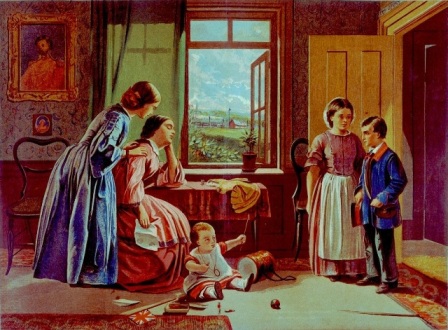
"The Telegram"
The delivery of the worst possible news to a soldier's family
by a
messenger of the Electric Telegraph Company.
Through the open window can be seen the railway station and
the telegraph wires.
A double-page, oil-print colour picture
published in the 'Illustrated London News' on February 25, 1860, from a painting by
Thomas Edward Roberts (1820-1901)
Original image courtesy of the BT Archives
The Telegraph Office
The telegraph companies in their public presence were retail concerns.
Originally they operated through their own telegraph offices at railway
stations, then eventually during the 1850s, and more often, in the high
streets of Britain's cities and towns; effectively these were all
'shops'.
The transaction followed a common course in all of the companies. A
message, written on a form and signed by the sender, was handed in to a
telegraph office. After being pre-paid for in cash, or latterly in
telegraph stamps, the text was transmitted electrically to the nearest
station to the address in the message, where it was written down in
long-hand on another form by a clerk as received and immediately
despatched to the recipient by a foot messenger.
The Electric Telegraph Company sent
Telegraphic Despatches,
the early British and English & Irish companies did not give their
messages a special title, and the later British & Irish, London
District and United Kingdom companies were to use the neologism Telegram
in their businesses. The word 'telegram', originating in April 1852 in
America, began to enter the popular English vocabulary from around 1853
or 1854.
The public entered the office and handed over a
message forwarding form at
a shop counter; behind the counter were shelves with the telegraphic
instruments and the batteries of electric cells. The clerks received
the messages and worked the telegraphic instruments.
In all except the largest City offices the
instruments were visible to the public. The needle instruments were
large; contained in handsome pieces of glass- fronted cabinet-work, the
bodies mainly in mahogany or oak, or occasionally veneered soft-wood.
They were often ornamented with fine-carved scroll-work and columns.
The common double-needle apparatus was around twenty-four inches tall
by fifteen inches wide, with a six inch square box for the alarm on
top. The earliest single-needle instruments of Highton were similarly
substantially housed, in pointed-arched cabinet-quality cases about
twenty-four inches tall and nine inches broad. Dial faces were often
silvered and lacquered, later coloured enamels were used to contrast
with the blued metal needles. The needles were later enamelled in
white. Within the instrument the workings occupied a small space
unrelated to the cabinet size, especially after the alarms were removed
in the 1850s. The outward size and material quality was intended to
represent the importance and value of their function.
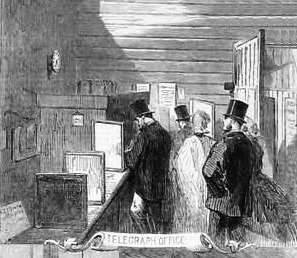
The Telegraph Office at the International Exhibition, Dublin 1862
Almost the only accurate view of local public telegraph facilities
in the 1850s and 1860s
The degree of public service was variable; for instance, even in quite small towns the company's telegraph offices were open twelve hours a day, from 8am to 8pm, six-days-a-week, but the offices at rural railway stations, not all of which on the line had telegraphs, were open, along with the ticketing offices, only at the times when trains were due. The bulk of public telegraphic traffic, estimated in 1867 as between three-quarters and four-fifths of all business, was communicated between the hours of 10am and 4pm between twenty offices in the largest cities.
The following forty-nine cities and towns in Great Britain had a twenty-four hour a day telegraph service in 1860, by either the Electric or Magnetic companies' circuits: Beattock, Belfast, Bilton Junction, Birmingham, Bristol, Broxbourne, Cambridge, Carstairs, Chester, Coatbridge, Coventry, Crewe, Cromer, Darlington, Derby, Doncaster, Dover, Dublin, Ely, Glasgow, Greenhill, Kingston (Surrey), Lancaster, Liverpool, London, Manchester, Milford Junction, Motherwell, Newcastle-upon-Tyne, Normanton, Northallerton, Norwich, Peterborough, Preston, Rugby, Selby, Southampton, Stafford, Stirling, Stratford (Essex), Thirsk, Tweedmouth, Warrington, Watford, Wolverhampton, Wolverton, Worcester and York.
By the late 1860s there were around 220 minor railway stations where the telegraph company did not maintain a separate office but the "station master might send and receive messages to oblige residents". There were in addition 350 other "auxiliary stations" where railway staff could accept messages for forwarding for an additional fee, which they kept as a gratuity.
In many towns, where the telegraph was distant, hotels and other public establishments served as "Official Agents" of the telegraph company, to transact its business. These would forward by messenger any message received to the nearest office, usually at a railway station, at extra cost.
During the mid-1850s the many railway news-stands and bookstalls of
W H Smith & Sons accepted the message forms of the Electric
Telegraph Company, passing them on to the instruments at the railway
stations that they served. W H Smith was a director of the Company.
It was not until the 1860s that the majority of telegraph offices were open on Sundays, and then only for limited hours in the morning and late afternoon. Where the service was available there was a 1s 0d additional charge for Sunday messages.
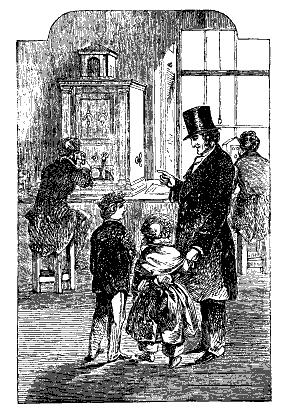
The general public only gradually frequented the telegraph; in
Liverpool in early 1854 of 4,993 messages examined, rather
impertinently, by the Magnetic company only 201 or 4% were personal or
domestic in nature, the balance were all sent on business, although 233
did relate to betting, which might or might not be personal. When the
exercise was repeated by the Magnetic thirteen years later in February
1867, with an analysis of 1,000 messages through Liverpool, 124 or 12½%
were defined as personal, and just one involved betting – indicating at
least a moral improvement? Again the balance was related to commerce.
Another survey, of a thousand messages, by the Magnetic in 1853 showed that the speed of a message from the sending counter in its stations to the receiving counter averaged from 4½ to 5 minutes.
On January 1, 1858, ‘The Telegraph
Guide’, intending to be a monthly publication, was announced, being a complete
guide to every telegraph station in the United Kingdom, with hours of
attendance and charges from London, Liverpool, Manchester, Dublin, Glasgow and
Hull to every other telegraph station in the country. With a price of 1d, a
circulation of 10,000 a month was promised by its publishers Lee and
Nightingale in Liverpool. Surprisingly, given the complexity of the national
network in that year, it was not a success.
The dependence on the commercial and professional classes for revenue is best demonstrated by the proximities of the telegraph offices in London. As well as their Stock Exchange and Royal Exchange branches, the several companies' closely-adjacent stations in Lothbury, Threadneedle Street, Old Broad Street and Cornhill were next to the banking, financial, mercantile and shipping firms in the City. Those in Mincing Lane and Mark Lane in the east of the City were for the produce and commodity markets. The legal profession, and latterly the press, were served by the telegraphs in Holborn, Chancery Lane, Strand and Fleet Street. Only the common offices in Charing Cross and Cockspur Street could be said to serve a purely 'public' market.
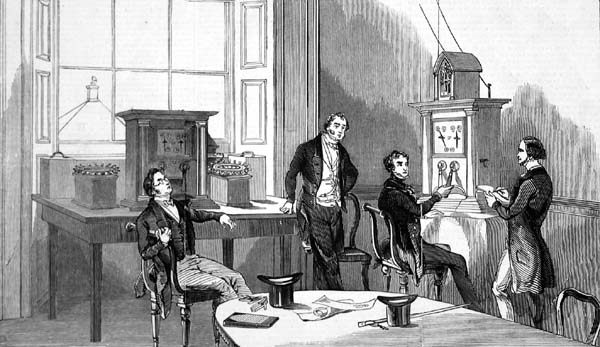
The Telegraph Office at Nine Elms 1844
Two-Needle and Dial Telegraphs at work during an electric chess match
The telegraph office front counters were all partitioned off into
spaces “from two feet to two feet three inches in width” where there
were pre-printed message- forms
on which the sender had to write their communication, along with the
customary institutional ink-wells, pens-on-chains and pencils. The
counter clerk wrote-in the charges to pay and a unique message number.
On the reverse the form listed the contractual obligations of the
Company; the form had to be signed by the sender in agreeing to these.
The larger offices
"had counters at a height suitable for writing, when standing, and
sub-divided into spaces, with fluted glass screens between each, to
prevent any person seeing another's message".
In return for the message forwarding form the clerk provided a numbered Receipt to the sender detailing the recipient, the destination station and the charges paid or payable on delivery. Pre-payment was generally insisted upon for all public messages, but regular customers were permitted a daily account which had to be settled in cash each evening.
Message Receipt Form 1868
Issued at the stations of the Electric & International Telegraph Company
on sending a message. On the back is a list of the stations in London
and some of the most important towns
For people who could not write the clerk would fill-in the message form and read it back to the sender, ensuring after that they made their "mark" of recognition.
All of the telegraph companies in Britain accepted messages in foreign languages, but at the sender's risk.
The message number was entered on to a list and the form passed to the instrument. Once the message had been sent the form was returned to the counter clerk who crossed it off the list and set it aside for filing. If, by reference to the list, the message had not been sent and returned within fifteen minutes it was chased-up.
Originally no one was allowed free messages; the directors and shareholders of the telegraph companies paid the same message rate as the public.
There were two other printed forms used by the office clerks: the Message delivery form, used for received messages, and the Message transmission form, used within the larger offices for transcribing or copying messages from one circuit to another. Each sort of form was printed on different coloured paper.
Where porterage or delivery to a
distant address was estimated and paid in advance any 'overplus' was
repaid with a money order drawn
up by the secretary, cashable at any of the Company's offices. These
orders proved a fruitful source of petty theft by the less responsible
among the "boy" clerks.
Odd stationery included Advice Notes left at addresses by messengers to show a message had to be collected; an Indemnification Note to be signed by the sender if a message might render the Company liable to action; a Number Sheet that the instrument clerk had to fill-in each day logging his work; and a Transmission Note where a message had to be transcribed to another company's circuits. There was also a pre-printed Funds & Share List that just had to have the numbers added next to the appropriate stock title.
The companies distributed a Card of Rates from most large towns as part of their publicity.
Issued to message senders by the London & Provincial Telegraph Company,
the new name for the London District Telegraph Company.
There was an advertisement on the reverse.
The telegraph companies were periodically criticised in the press for errors and delays in transmission of messages. However in the mid 1850s only one in 2,400 messages on the Magnetic company's circuits was found to contain error, and two-thirds of these were due to the "indistinct writing" of the sender. Even the oft-vilified London District Telegraph Company insisted that only one in 2,000 of its messages was subject to complaint. The number of messages "lost" in transmission was, over the companies' lifetime, in single figures. Delays of over one hour in sending on national circuits were reported by messenger to the sender with the options of cancellation and a refund or sending when possible.
During 1864, after being criticised in the London news press, the United Kingdom company revealed that it received on average one complaint for every 1,729 messages sent using its American telegraphs.
However in 1853 a telegraph clerk in London incontinently added an
extra zero to a merchant's order for £8,000 sent from Manchester.
Fortunately it was questioned by the merchant's agent at the Founders'
Court station and the error immediately discovered without reference to
his distant principal as it had been recorded on the tape of a Bain
printer.
On October 7, 1846 one of the grimmer aspects of electric
communication was brought home on the circuits of the South Eastern
Railway. A man named Hutching, who had poisoned his wife, was to be
hanged at Maidstone gaol at 12 o'clock on that day. The Home Secretary
on receiving a representative of the condemned telegraphed Maidstone
with a stay of execution of two hours whilst his officials investigated
the appeal. The new evidence proved inadequate and the Home Secretary
sent another message by telegraph instructing that the execution should
proceed immediately. The clerk at London Bridge station refused to send
the message for the execution without additional authority; his refusal
was endorsed by the railway company's chairman, James McGregor. A
messenger had to be sent to the Home Office in McGregor's name to
obtain the personal written instruction of the Home Secretary. It was
received and Hutching was hanged that afternoon.
Electric Telegraph Company - Station Staffing 1860
........................Male...........Female
.......Messengers
Liverpool............21...............25................23
Manchester........28...............21.................19
Glasgow..............15.................-...................8
Edinburgh..........12.................-...................8
Birmingham.......16.................-...................8
Hull.....................9..................-..................4
Leeds...................8..................-..................6
Aberdeen............4...................-..................2
Bristol................16..................-..................6
Nottingham.........3...................-..................2
Stock Exchange...6...................-..................2
Southampton......9.................. -.................11
Central Station....6..................107.............93
The Correspondence Department, the largest in the Company, managing the message traffic, consisted of District Superintendents, Cashiers, Chief Clerks, Counter Clerks, Instrument Clerks and Messengers. In minor stations the role of chief clerk, cashier and counter clerk might be combined.
The Counter Clerk, probably the most important individual in the Company's structure, received messages, computed charges, received payments, enclosed messages in envelopes and despatched them by messenger. Except in the largest offices where there were Instrument Clerks dedicated to working apparatus, the Counter Clerk also sent the messages.
The Cashier was employed in large stations or in District offices to record income and disbursements.
The Chief Clerk, called by the Electric Telegraph Company, the 'Clerk-in-Charge', kept the diary, the complaints-, the mail- and the general order books. As the station manager he was also responsible for the Messages Forwarded Book, the Messages Received Book, the Porterage Book, the Postage Book, the Gratuities Book, the Petty Cash Book, and the Pay Bill. Each month there was a Balance Sheet to compile and summaries of the office books, as well as a Weekly Instrument Report and a Weekly Signal Report on the state of the circuits, and Monthly Returns comparing the last three months and the year-on-year figures for head office. For offices at railway stations there were also Railway Message and Railway Signal Books to maintain. Messages there were carefully divided into Commercial and Railway.
One of the more arcane functions within the telegraph office was that known as translating. This involved the rewriting of the sender's message into an abbreviated telegraphic script before being passed to the instrument; and the reverse function at the receiving end. The companies in Britain reduced each of its station addresses to two-letter codes; in addition letters, syllables and portions of words were excised, with conventionalised instrument signs introduced for full-points, paragraphs and underlining to shorten the message.
Common words such as 'the', 'from',
'and', 'to', 'you', 'yes' and so forth, and terminations such as
'-tion', '-ing', and '-ment', were reduced to signs.
As a cautionary note, the word "translating" was used in telegraphy at the time to represent several other functions including forms of electrical relay.
Early CodesFrancis Whishaw, who managed the message department from 1845 to 1848, devised a translating system for business traffic sent by the Company similar in principle to short-hand. Codes were prepared for shipping, horse racing, share lists, corn-market prices, and so on. The sending clerk signalled the code being used and the common phrases and words for that special traffic were substituted by arbitraries, as in short-hand. This translating system reduced message length on a ratio of five to three, five hours work might be done in three.
Frederick Ebenezer Baines, a former telegraph clerk, gave a description in 1895 of the earliest codes used by the Electric Telegraph Company:
“The ‘codes’ were not those used by the public for the sake of shrouding the meaning or lowering the cost of telegrams, but Whishaw’s Codes of 1846, which substituted a brace of letters for names of men or places or a group of words.”
“They were ingenious devices, but of little practical utility. Out of these, however, came IK, the code equivalent of the name of the chief station (Lothbury).”
“The double-needle apparatus of Cooke and Wheatstone was in use. The needles at first were long and heavy. They waved to and fro across the face of the dial with exasperating slowness. About six or eight words a minute was a fair working speed, so the saving or abbreviating of words was of real importance. In later years, with shorter and lighter needles, as many as 40 words a minute could be read with ease, then codes were of still less value.”
“Mr Whishaw’s codes, however, furnished a good deal of information by the use of four letters - two for principles and two for details. Thus, ZD or ZL meant a number of some sort; AM a particular number - one for instance. ZY meant a telegram of some sort, CW a private one. So in this rather cumbrous way the first paid private telegram of the day was signalled: ZD, AM; ZY, CW. [i.e. Number One; Message or Telegram, Private] A telegram in the earliest days of all was delivered to a merchant in Sheffield with these cabalistic signs upon it, much to his bewilderment.”
“CW existed until recently [1895]; amongst the old stagers it is still understood, but M has freely taken its place. ‘What caused the delay?’ would ask an official querist. ‘A very long CW to Birmingham,’ might be the answer forty years ago; or as now, ‘Derby had a good many M’s on hand.’ ”
“ZM referred to wind and weather. ‘ZM fine,’ is still a frequent entry in the office diaries, London fogs notwithstanding. DO for shipping news, and CS for Parliamentary intelligence, survived until the transfer of the telegraphs to the Post Office. Then the work of editing news was handed over to the news agencies, and many of the old codes fell into disuse. CQ, meaning all stations, still holds its own.”
“PQ was one of the last to go, as it was, in the order of signals, the last for use in a message. It was an innocent code enough, meaning only ‘end of message.’ But under certain circumstances it could goad the distant operator to fury; because, abruptly given, it might have the significance of ‘Shut up!’ ‘You’re a muff!’ and other interjections more vigorous than polite. Now, for the clerk, say at York, to be PQ’d by IK [Lothbury] in the middle of some courteous explanation of the causes of slow reading 200 miles away, was more than the best-balanced mind and strongest apparatus could stand; and it was a common occurrence for the stout brass handles of the double-needle telegraph to be broken off by the aggrieved clerk in the white heat of his passionate telegraphic remonstrance.”
“Beside IK for London, Whishaw’s Codes provided IH for Liverpool, AP for Manchester, GX for Hull, KM for Newcastle; EL for Edinburgh, FO for Glasgow, and so on. The initials did not necessarily bear any relation to the names of the places, and ultimately the codes were rearranged in order to produce some sort of connection between the two. The LY stood for Lothbury, instead of IK; and MR for Manchester, BM for Birmingham, GW for Glasgow, etc., replaced the arbitrary codes formerly used.”
Baines imagined an early conversation using the Whishaw Code:
‘Are you through to KU [Normanton]?’ might have inquired the genial manager, Mr W H Hatcher, circa 1850, of Mr [John J] Jackson, the superintendent [at Lothbury].
‘Not yet, sir; there’s a want of continuity on the stop E, and full earth on the HN’ (i.e., the left-hand wire to Normanton is broken, and the right-hand wire touches the earth).
‘What are you doing with the CW’s?’
‘Sending them to MI (Rugby) to go on by train.’
‘What is wrong? How is the ZM [weather]?’
‘High wind and heavy rain in Derbyshire. I think the linemen are shifting a pole.’
Diarial entry: ‘11.30, line right. KU reading well.’
Then an unofficial conversation by telegraph between Normanton [KU] and Lothbury in London [IK] -
‘How many CW’s at IK?’ asks KU, about 180 miles away.
‘Twenty-three,’ replies IK.
‘All right; will clear you out.’
Joy overspreads at IK the face of J M, aged fifteen. He signals ‘ZL’ (all being messages for stations beyond Normanton, otherwise he would have sent ZD), and away fly the CW’s, the double-needle rattling like the stones of Cheapside under the wheels of Mrs Gilpin’s chaise*. All twenty-three messages are taken without a single ‘Not Understand.’
‘Good! good! good! [GD, GD, GD]’ signals IK, in a paroxysm of praise.
(* from ‘The Entertaining and Facetious History of John Gilpin’ by William Cowper, 1783)
Other arbitrary early call signs used by
the Electric Telegraph Company for busy offices included KX for the Stock Exchange,
KR for Cardiff, RW for Derby, KT for Stockport and VT for Coventry.
Eventually, as Baines noted, by the
1860s, the major cities and offices adopted, officially or otherwise, more obvious
calls: Liverpool LV, Newcastle-upon-Tyne NC, Edinburgh EH, Dublin DB, Belfast
BT, for example. The other telegraph companies had different call signs for
their offices, the Magnetic used LN for Threadneedle Street, the United Kingdom
company GH for Gresham House, and the District CO for Cannon Street, all in
London. The Magnetic’s calls were commonly distinguished by being three letters
long.
As well as being used in transmission the
calls were incorporated into the india-rubber obliterating stamps used on
accepted message forms and frank stamps at the offices.
"I hope you will join the crusade against the use of the new word 'telegram'. It comes to us from the Foreign Office, I believe. Certainly, no Englishman at all aware of the mode in which English words are derived from the Greek language could have invented such a word. If it should be adopted, half our language will have to be changed."
"We shall have to say paragram instead of paragraph, hologram instead of holograph, photogram instead of photograph, autogram instead of autograph, geogrammy instead of geography, lexicogrammy instead of lexicography, astrogrammy instead of astrography, lexicogrammer instead of lexicographer, polygrammy instead of polygraphy, stenogrammy instead of stenography, stereogrammy instead of stereography, horogrammy instead of horography, ichthyogrammy instead of ichthyography, micogrammy instead of micography, metallogrammy instead of metallography, &c. In short, we shall have to retrace our steps, and entirely alter our manner of forming English words from the Greek. Have all our lexicographers been wrong? And is the author of 'telegram' the only person who is right?"
Special signs were also used unofficially between the clerk-operators by 1848 to represent emotions such as laughing and astonishment. The adaptability of human nature to this the most revolutionary of technology was remarked on at the time.
The Electric's C F Varley noted in 1859 that "telegraph working generally causes great nervous irritation, and the clerks are very prone to quarrel". He cited delays caused by impatience with repeated errors by distant colleagues leading to electrical arguments, and to clerks refusing to work with those on some lines.
Every message had a Prefix consisting of two or three letter codes.
The first was the Message Type: free, special express, government,
chairman's, duplicate, ordinary, danger, transmit on, engineer's,
urgent, insured, repeated, train report, company and private. This was
followed by two letter Station Codes, the "calls", LY for Lothbury, EN
for Euston Square, WV for Wolverton, RY for Rugby, YK for York, for
example, to identify the originating office and the destination, and a
two or three letter Time Code.
After the message was an Affix, also in the form of short letter codes usually dealing with delivery: acknowledgement paid for, answer not paid for, forward by boat, forward by cab, forward by best means, forward by omnibus, forward by train or another telegraph, to be called for, completion of address, forward by first train, forward by cab or messenger up to three miles, instructions to follow, porterage not paid for, forward by most rapid conveyance without regard to cost, forward by special express,forward by post, reply paid.
There were arbitrary responses signalling Engaged, Engaged to all business and Now Un-engaged; for Repeat all, Repeat from, Repeat word after, Repeat word before, Repeat words from/to, Word Number incorrect, Wait, which indicated an error in transmission, and All Right, when the error was corrected. There was a "collate" signal inserted into messages that indicated the next word was to be repeated back to ensure accuracy. There was also the End signal at the termination of the message, and the all-purpose Good signal (GD) which was the British equivalent of OK.
Interruption of messages was forbidden; the reason for the signalling of the Wait code from the receiving station had to be documented.
In the early days of the Magnetic company each word had to be
confirmed as it was received by the instrument clerk to ensure
accuracy.
Business customers were allowed use of commercial Telegraphic Vocabularies
that substituted words and numbers for most common phrases. These were
published with the object of shortening messages for economic reasons
rather than to conceal the content. The Magnetic company estimated that
one message out of four was encoded in 1853.
However, stockbrokers, produce-brokers, merchants, banks and betting-men used codes and ciphers, commonly called a Private Key, for their confidential messages from the earliest days. The words in their Private Key, or code book, could not exceed two syllables to prevent abuse of the tariff and confusion in sending. Banks also used an authorising code phrase that preceded the text of their business messages. The phrase changed each day. Such messages related to delicate subjects such as the returning of bills-of-exchange and the stopping of local bank notes. Remittances between banks of £20,000 and £30,000 were regularly authorised this way by telegraph in the 1850s. The banks also "enquired as to the respectability of parties" by wire in that period, keeping the "party" waiting in the bank parlour until the reply was received.
Receiving bulk traffic, news messages, for example, required two
clerks; one to read the instrument, the other to write down the script
in a manifold book of alternate flimsy sheets and carbon-paper. The
original was delivered to the recipient, the facsimile kept for the
record. The sending of such messages required considerable
concentration, flicking attention from script to instrument, sending
letter-by-letter without translation. It was this traffic that, in the
earliest days, the Bain and American writers were intended to mechanise
and render more accurate especially on long and busy circuits. News
messages having special importance or priority were sent Express or in industry vernacular as Expresses.
Apart from government traffic, which the Companies were obliged in law
to give preference, 'Expresses' of news were then the only priority
paid messages.
Whether sending or receiving, the unique number and the hour and minute of commencement and completion of each message were recorded, and signed-off by the clerk. All of this detail and the message content was entered into the books of the Company, along with the charges paid, for accounting purposes and in case of any dispute with the sender or recipient.
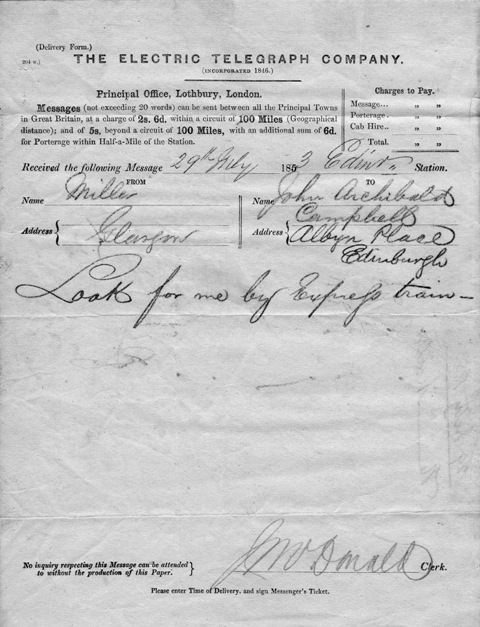
Electric Telegraph Company Delivery Form 1853
What came to be called a "telegram", hand-written by the clerk
in pencil on a "manifold writer" to make a duplicate copy
As
well as news all other messages were written out by the receiving clerk
on a "manifold writer" (i.e. copying by carbon paper) and a duplicate
copy of every message sent by telegraph was forwarded by rail to the
Central Station at Lothbury to be compared with a copy of the original;
through this process it was said that the clerks had to be particularly
accurate, and the public efficiently protected from error. The copies
were parcelled-up, placed in hampers and kept under lock-and-key for
two years before being pulped.
At the Central Station where the business was intense there was a division of the clerical work into three areas which would otherwise have been done by one or two individuals: 1] two clerks to each instrument, one to read or send the signal, one to write down the received messages; 2] registering, numbering and making an abstract of each message; and 3] pricing, folding, sealing and addressing the message.
From the earliest systematic use of telegraphy in Britain the clerk-operators could recognise the telegraphic hand of their regular sending colleagues hundreds of miles distant, and engaged with them in private, unofficial electrical banter, to management's disapproval.
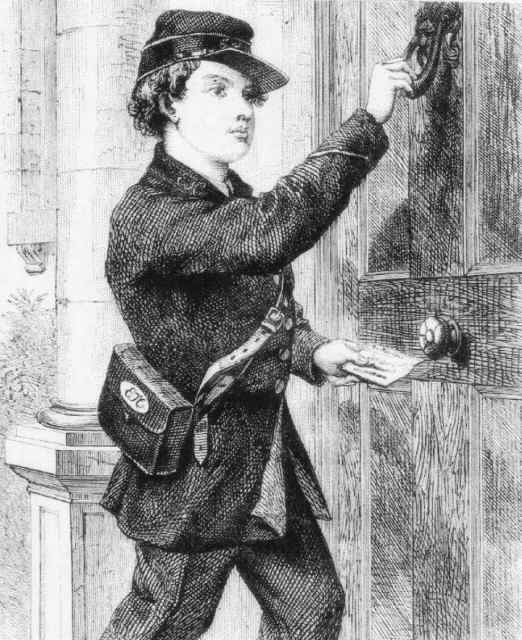
A Messenger of the Electric Telegraph Company
The
frock coat was in dark-blue with a scarlet collar and scarlet
cuff piping,
the trousers were grey. The cap was dark-blue with a
broad scarlet band, originally a flat-topped military pattern, later in
the French-style shown.
ETC monogram on cap, collars and pouch.
The other principal category of employee in the office was the uniformed messenger, a young boy, who carried the received message forms to addresses within one mile of their office in, as the Company stated reassuringly, carefully-sealed envelopes. For messages received on the Hughes type-printing telegraph the printed tape was cut into short lengths and glued to the ordinary received message form, for the convenience of business people who filed them as letters, before being folded-up and inserted into the envelope; only the outer address was hand-written. In the United States the printed tape was simply put in the envelope.
In Britain and the United States messages were always sent out in envelopes. In most other countries the message sheet was folded several times, the address written on the outside of the message form and one edge sealed with a small adhesive telegraph label.
The small white envelopes of the Electric Telegraph Company carried their crest and the exciting (or terrifying) injunction “Immediate” printed in red on their face. Those of the Magnetic company were overprinted blue with its crest. The District company had demur plain brown envelopes simply marked “Telegram”.Each messenger carried a book of numbered Receipts that recorded the message's number, sending and delivery times and any charges to pay on delivery. The messenger had to obtain the recipient's signature on the receipt. No tips were permitted.
Where no messengers were employed, in the smallest offices, the
message was passed to a self-employed porter or a railway porter at the
sender's risk, or put into the Post Office mails for delivery.
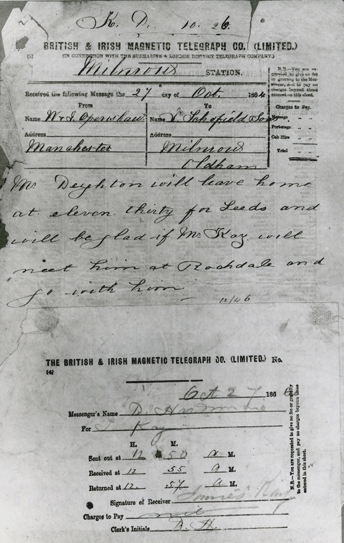
British & Irish Magnetic Telegraph Company Delivery Form 1864
along with the Messenger's receipt
There was a list of telegraph stations and foreign rates on the reverse
The Electric Telegraph Company issued a number of
manuals for the guidance of its staff: the principal of these were the
General Regulations.
Originally in 1850 these were in two parts, for clerks in stations and
for inspectors and linemen. But these were eventually combined into a
single 72 page volume. There were also Tariff Books,
especially for continental traffic – which ran from 37 pages in 1859 to
89 pages in 1866 as the foreign connections developed. Instrument
galleries used the 12 page General Code Book listing the
two-letter arbitrary substitutes for words and syllables. The Company
printed one-sheet Double-Needle and Single Needle Alphabets for
training.
At its busy Founders' Court and Charing Cross offices in London the Electric Telegraph Company, as a charitable gesture, allowed red-coated boys from the Saffron Hill Ragged School's "Shoeblack Brigade" to earn an income carrying messages and packages for patrons.
The common telegraph office in a medium-sized provincial town employed only two or three people, the clerks mainly young men, usually called 'boys' or young women, always termed 'ladies', and the messengers, working long 'shop' hours, six-days-a-week, in small, often shared premises.
Clerks and messengers worked either nine hour days
or eight hours during the evenings and nights. Only older, male clerks
were permitted to work at night.
The instruments and apparatus used in telegraph offices were limited in number. The assembly included:
• Telegraph – the sending and receiving instrument, commonly a single-needle instrument in circuit with the line and the battery
• Galvanometer – a small desk-top instrument for measuring the current in the line circuit; a portable galvanometer used to test battery and external circuits was called a Detector
• Bell or Alarm – in the line circuit to call the attention of the clerk to activity on a message circuit
• Relay – used in the message circuit to automatically forward messages and to maintain any loss of current by using its own battery
• Turnplates – small rotating switches used to direct circuits between instruments and between batteries and apparatus, also termed Commutators
• Switchboard – used in large offices to manage message or battery circuits instead of turnplates
• Battery – a set of chemical cells that produced the current, usually in a secure place as they contained volatile chemicals, the battery circuit ran to the telegraph instrument and to the relay
• Lightning Protector or Paratonnerre – a device in all offices inserted in message circuits between the line and the instruments
• Screw Connectors – small brass devices used to join circuit wires together
Circuits
In the simplest terms the original electrical circuits for
telegraph comprised a main and return; these were both wires until the
earth return was introduced. Other than for two-needle instruments each
circuit was then essentially a single wire.
The several telegraph stations were all, at first, connected to the same circuit. Each sending and receiving instrument had an alarm attached so that once current was applied the bell rang on all those in circuit to attract the clerks. The alarm was originally continuous and then just a series of single beats. The sending clerk would signal a short two-letter "call" message with the intended station's identification code; the clerk at the appropriate station would then acknowledge the call and take the incoming message whilst the others ignored it. The sending clerk had to repeat the call announcement until it was acknowledged.
All of the stations in the circuit could read the through traffic to other destinations.
With the coming of more intense traffic the ringing of all the bells on the circuit was an unnecessary nuisance as the ticking of the needle became sufficient and the alarm became an accessory only in branch stations. With traffic over great distances or to branch lines where there was no continuous circuit the 'call' signal would be received at a large office, acknowledged, and diverted through to another line using either simple switches or a switchboard to create a circuit. Once this was connected the 'call' signal would need to be repeated again until it was acknowledged. The message could then, after a delay, be sent.
Where no switching for a through circuit was possible the message
was transcribed, re-written, at the intermediate station and re-sent at
a later time (if pressure of work was the cause) or taken to another
instrument on the correct circuit, if no direct connection existed. The
traffic between the busiest stations soon required separate or
dedicated circuits, either a direct, point-to-point, line, or one with
only a limited number of intermediate stations in parallel with the
existing ones. The planning and constructing of these separate circuits
was a critical issue in the telegraphic business.
By 1852 the ordinary lines were divided into Divisions of between four to six stations, between two larger offices, between London and Birmingham for example. These could then only have direct internal access. The messages in or out of the Division had to be switched or transcribed at the larger offices.
One of the duties peculiar to British telegraphy was that related to the need to regularly re-magnetise the receiving needles of the instrument, which gradually lost power over time. Instrument clerks each possessed a permanent magnet for this purpose.
Electric Telegraph Company - District Staff 1860
..................Inspectors – Mechanics – Linemen – Labourers
North..................7............1..................20...............60
South West..........2............1.................10................10
London
...............4............4.................6...................-
Midland...............3............1.................7..................50
Western...............7............1.................29................140
Scottish...............5.............1................16.................?
Great Eastern.......4.............-................11.................40
North Western....10...........3................30.................58
Irish.....................3............1................16.................7
In addition there were 18 crew members on the cable ship Monarch and 108 workers in the Company's stores
An Evening with the Telegraph
This long descriptive piece was published
in Chambers’ Edinburgh Journal, on January 4, 1851:
“The spider's touch, how exquisitely
fine,
Feels at each thread, and lives along the line.”
On arriving at the ------------ station,
I found that my luggage, which was to have been sent on from town, had not
arrived. There was no time to be lost, and on applying to the superintendent of
the station, an order was given to make inquiries at London by means of the
telegraph. Impatient to get some information about the missing baggage, I
strolled to the electric telegraph office, to hear what was the answer
received. But no satisfactory information had as yet been obtained; on the contrary,
nothing at all was known about the matter. I wanted another message sent up to
town, but on working the needles, it was found that the telegraph was engaged
in corresponding with some intermediate or branch station.
The clerk, with whom I continued chatting
through the little opening where all communications are given and received, was
very young; but there was something in his manner that prepossessed you
favourably, and, moreover, there was a total absence of that abruptness of
speech and quickness of manner that seem to have become a second nature with
our railway officials. At last he invited me to enter his office - the very
thing I had been manoeuvring for and longing to do - for as I squeezed my head
through the small opening, and looked into the snug room, warmly carpeted, and,
although it was the beginning of August, with a fire burning in the grate, I
could just catch a glimpse of the small mahogany stand and dial of the
telegraph, with which he had been talking to the people in London about my
trunks, and was very desirous of seeing a little more. Books were lying about
the table, which seemed to indicate a taste not only for literature, but for
its more imaginative productions; and so, then, as we sat over the cheerful
fire, our conversation taking its tone from the volume into which I had dipped,
we chatted about authors, style, and such matters.
“You would hardly believe,” he said, “how
such an employment as mine teaches one curtness: how one gets into the habit of
saying what one has to say in as few words as possible, and yet with perfect
clearness. I write occasionally little articles, and I find that in them I
unconsciously avoid all redundancy of words, just as when transmitting a
message. You have no idea what a lengthy affair the messages are which we have
given us to transmit, with so many useless expressions that make the inquiry,
or whatever it may be, nearly twice as long as necessary. In delivering it, we
cut it down about one-half, and yet our version tells all that is to be said
quite as intelligibly as the original.”
“The cause, no doubt, is, that those who
want to give some information about a missing thing are anxious to describe it with
all exactness, in order to make as sure as possible of its being recognised.”
“But the details on such occasions,” he answered,
“are really without end. Now we, for our parts, seize on the salient features:
we give the necessary marks or tokens, and these only. For nothing is the
telegraph so often put in requisition as to inquire about ladies’ dogs that are
missing. Hardly a day passes without such inquiries. And such descriptions! A
perfect history of the animals’ habits and virtues: it seems they never can say
enough. I have often thought how they would be shocked did they but see how all
the long history of their favourites is condensed into a couple of lines. And
yet it answers the purpose as well.”
He here turned round to the dial-plate of
the telegraph, and after a moment's watching, looked again into the volume, the
leaves of which he was turning over.
“Was any one speaking to you ?” I asked.
“Not to me; they are talking with the ------------
station.”
“But how did you know it ? - what made
you look up?” I asked.
“Because I heard the wires.”
“That's very strange,” I observed: “my
hearing is unusually fine, yet I heard nothing.”
“'It is habit; besides, perhaps, you
heard the vibration too without knowing what it was. My ears are alive to the
sound, that, as I sit here reading, the instant the hands of the dial move, I
hear them. That low click-click attracts my attention as surely as the bell.”
“There is an alarum, is there not, which
sounds when the clerk's attention is required?”
“Yes,” he said; “this is it.” And so
saying, he touched a wire, and instantly a hammer struck upon a bell, making a
slow, penetrating, long-continued noise. “But I generally stop the communication
with it, for it is so loud, that it is extremely disagreeable to be disturbed
by the ringing of that thing at one’s shoulder. Besides, I hear the other just
as well, let me be never so immersed in what I am about.”
I now heard such a snap as takes place
when, on putting your knuckles to an electric machine, the spark is produced.
It was repeated, and on looking up, I saw the needles reeling to and fro. The
clerk observed them for a moment, and then rising, went to the machine. Backwards
and forwards they went, to the right and to the left, then with a jerk half-way
back again - left, right, left - left, left - jerk, jerk - right, left, jerk,
and so on; while the clerk, who held two handles hanging from the instrument in
his hands, every now and then would also give a good rattle with them, and pull
them right and left, and give an answering jerk. All the time, of course, he
was looking fixedly at the dial-plate, as he would have done into the
countenance of a person who was speaking to him, and whose character he fain
would learn from his looks. Jerk, jerk, jerk - rattle, rattle, rattle - all was
done; and writing down the message on a slate beside him, he copied it
afterwards on a paper to give to one of the porters. It was about some boxes
sent on to ------------ by the last train.
“I know what clerk sent down that
message,” he said. “It was ------------ .”
“But how do you know which clerk it was ?”
“By the manner of his handling the
needles, and their corresponding movements. I am as sure who is working them as
if I saw the person with my eyes. You of course would not detect any difference
in the vibrations, yet there is a very great difference. There may be timidity,
indecision, flurry, or firmness, in their movements. You see quite clearly if
the person speaking to you is master of what he is about; if he does it with
ease and decision, or if he is spelling his way, and anxious about getting
through the matter well. And it is not only the quickness of the delivery that
shows whether the person is skilful or not, but his very character communicates
itself to the wires, and shows itself in the movements of the needles.”
“How strange! - and it is really
possible?”
“That in a man’s movements much of his
character is shown, you will allow. Well, as he takes hold of the handles to
work the telegraph, he does it in a way corresponding with his own particular
individuality. That is communicated to the wires, and here on the dial-plate I
see the inner man before me. The person I just mentioned is a very good fellow, but
cautious, undecided - never sure whether what he does will be quite right or
not. He is always hesitating; as soon as his hand touches the instrument, I
know it is he instantly. There go the needles slowly from one side to the
other, as if not quite certain about going across or not; they never go back
suddenly, but always take their time, and move right or left hesitatingly, and
with no decided swing. It is as like the man who is moving them as it is
possible to be. It is quite a reflex of his mind: there is the impress of him exactly
as he is. And it is very natural it should be so. The least hesitation or doubt
communicates itself involuntarily to the hands as you hold the handles working
the telegraph; and so fine and sympathetic is the conducting power - so
sensitive are the wires- that every passing shade of feeling is felt by them.
On the dial-plate it is all betrayed. Just as the mind of him at the other end
of the wire is wavering, exactly so the needles are wavering too. Now he feels
more sure; and yet that very same instant the change that has gone on within
him is marked there also: the needles swing directly with sudden decision.”
“This is really very interesting,” I
said; “and it is besides, to me at least, a new wonder connected with electric
communication. That one should be able to talk with a person a hundred miles
off, as if they were both face to face, is certainly extraordinary; but that
the affections of the mind and their sudden varyings should be instantaneously
transmitted such a distance - perhaps even before the individual himself was
aware of them - this is assuredly very much more wonderful!”
“'It is not,” he continued, “in the
manner of delivering a communication only that you discover the sort of person
with whom you have to do. The way in which he receives yours is also very
indicative. One, slow of thought, will let you give the whole word; while another,
of quick comprehension, and of a bolder nature, will give the sign, ‘I understand,-
at the first letters. The very jerk too, which signifies that you know what is meant, is given by one with a decided,
sure, firm knock; while with another, of a hesitating character, the needles
seem to be hesitating too!'
“Just now,” said I, “while you were
receiving a message, I observed that every now and then you gave an unusually
strong jerk - much stronger than the others. What did that mean?”
“Oh,” said he, laughing, “that was an
indignant ‘Understand!’ The other was stopping to see if I knew well what he
had said, and I showed, by my manner of saying yes, that I was out of patience
with his distrust. Such an ‘Understand,’ given in that brusque manner, is not
exactly very civil: but I really can't help it - one gets at last out of patience
with such dawdling.”
“And will the other, think you,
understand that his questions and slowness put you out of patience?”
“No doubt of that. I knew he understood
the way I answered him, and was sulky about it, for his manner changed
directly. In the way I said ‘I understand,’ was expressed besides, ‘Of course I
understand! Do get on, can’t you, and don't stop to ask such foolish questions!’
That is what we call an indignant “understand!”’
All this interested me much; and we
talked on, now about a favourite author lying on the table, now of this thing,
now of that, only interrupted occasionally by the click-click of the mahogany
case, that, like a something endued with life, was calling its attendant to
come to it, and take heed. But while there, as one in presence of some demoniac
thing, the telegraph exercised a sort of spell over me; and I always recurred
to it, much as our conversation on other matters would have pleased me at any
other time.
“You must not leave the telegraph for a moment?”
I observed. “There must be always some one here to watch it, and be in readiness?”
“'Yes; I or my brother remain here
always. We take it by turns. Night and day he or I am here. He is gone to-day
some miles off; so I have taken his watch for him. I was on duty before;
to-night, therefore, will be the third night I have been up!”
“It must be very fatiguing for you;
besides, you cannot venture to doze a little, lest something should happen.”
“'Though I were to do so, if the wires
began to move, I should awake directly. I cannot tell you how or why it is, but
if there is the slightest tremor, I am sensible of it at once. Whether I hear
it or feel it, I do not exactly know; but I am sensible that they are moving !”
“By intense watchfulness, by constant companionship
with that animate yet lifeless thing, a sort of sympathy, or magnetic influence
- call it what you will - may exist between you and it,” I observed.
“It may be so,” he replied; “but really I
cannot say. The strain of attention that all occupation with the telegraph
produces is very great. While reading off the communications just given, your
mind is on the stretch. The intentness of observation with which you must follow
the needles in their movements is very fatiguing. There is nothing hardly that
demands suck minute attention; for a slight mistake, and you lose the thread of
the meaning, and this directly causes delay. Besides which, you get confused.”
“This constant state of excitement must,
I should think, at last make itself felt. It would be highly interesting to
observe the influence it would exercise. Now, in yourself, have you,” I asked, “remarked
that any change has taken place since you have been occupied with the telegraph
- that you are more irritable and excitable than before - or that the constant
tension in which the faculties are kept has at all affected you ?”
“I think it has made me more excitable
than I was before. It certainly has an effect upon the nerves. Tho vibration of
the needles, for example, I should hear much farther off than you would - so
far, indeed, that you would think it scarcely credible.”
“Besides the constant attention and the
night-watching, I have no doubt that the incessant, quick, uncertain motion of
the needles backwards and forwards, and from side to side - that constant tremulousness
which you are obliged to observe and to follow so closely - must tend to
irritate.”
“Yes,” he replied, “I daresay it is so.
At night, however, one is seldom interrupted. Towards morning the foreign mails
arrive, and then the despatches for the newspapers have to be transmitted. This
takes about a couple of hours or more close, uninterrupted work. When a
correspondence continues thus long without a break, it is very tiring for the
mind. As soon as it is over, all has to be written down in a book: this is the
most uninteresting part of our occupation. Every message, important or not, is
entered in a journal, and then, from time to time (every month, I believe.), the
accounts and money received are sent in, and the journals at the different offices
compared, to see that all is right. All this is tiresome enough, but it must be
done.”
“In this way you hear all the foreign
news before anyone else. When the first morning edition appears, to you it is
already stale. I wonder, though, that persons who have anything secret and important
to transmit, should like to trust their secret to two individuals wholly
unknown to them.”
“Oh, there is no fear of our divulging anything,”
he replied. “Get something out of an electric-telegraph clerk if you can!
Besides, we are forced to the strictest secrecy; bound, too, in a good round
sum of money, which we must deposit as security (If I remember rightly, £500). There
is nothing to be got out of us, I can assure you. It would never do if it were
otherwise; for often matters of very great importance are forwarded in this
way, and the confidence placed in us must be entire, and our secrecy above even
suspicion.'
He afterwards showed me his dwelling.
Close to the office was a sitting-room, and opposite this the kitchen, &c.
Above stairs were the bedrooms; and though all was on a small scale, the
arrangements were as comfortable as one could wish. I observed this to my new
acquaintance, and that all was neat and well planned.
“Yes,” he answered, “it is so. The
company have not been sparing in making us comfortable. All is as nice as we
could desire it to be. It is really very necessary, however, that it should be
so; for, being obliged to be always here ready and on the watch, one could
hardly do without these little comforts. My brother and I are happy enough
together.”
“I should think,” I observed, 'the
employment must have much in it that is pleasant -a charm peculiar to itself?”
“You are right,” he said; “at first it
possessed an indescribable charm. There was something mysterious about it; and
it was with a strange feeling, unlike anything I had ever known, that I used to
find myself holding converse with others far off, and watching, as it were,
their countenances in the dial-plate. But the novelty over, all this died away;
and though I still like the employment, it is no longer invested with its
original charm.”
“Were you long in learning to work?” I inquired.
“Not very long - it is not so difficult;
but it takes a long time before you are able to read the communications sent to
you - that is to say, quickly and easily. The speed with which a message is conveyed
depends much on the person receiving it; for if he is quick and clever, he will
understand what the words are before they are spelled to the end; and so,
meeting the other, as it were, half-way, the communication is carried on with
great rapidity.”
Here the hammer of the alarum, which,
before we went into the other room, had been set, began making a tremendous noise.
“Ha!” said I, “someone is about to speak
with you.”
We went to the door of the little
parlour, and looked into the office at the needles. They were moving backwards
and forwards with their usual click-click.
“Is it for you ?” I asked.
“Yes,” he replied; “so many times to the
right, and so many times to the left, that signifies ------------ station.”
“What is it about?” I inquired, as I
watched the two needles, which, by their different movements over the small
segment of a circle, expressed everything.
“It's about the down-train to-morrow. We
are to send up some carriages.”
“And where is it from ?”
“From the chief station in town.”
The needles soon moved again.
“Is it still the people in London who are
speaking ?”
“'No: now it is the ------------ station”
I now had an opportunity of seeing how
quickly my companion read the movements of the needles. Incessantly came the
jerk, meaning “I understand;” again and again at quickly-repeated intervals.
Once there was an unusual movement, and I afterwards inquired what it meant.
“It meant,” he replied, “‘Say that once
more.’ I could not make out what was said; and, just as I imagined, the other
clerks had made a mistake.”
Now came the answer; and it was
astonishing how quickly it was delivered. As one's words pour out of the mouth
in speaking, so here they were poured forth by hands-full. How the needles
rushed backwards and forwards, then halted! now came a quick shake, and then
off they dashed to the side with a bold decided swing! There was no hesitation
here. Rattle, rattle, rattle; right, left, right: on it went without a pause;
and soon the people at ------------ had got their answer from the snug little
parlour at the ------------ station.
The evening had closed in, and there I still
sat over the fire. A fire - a coal-fire in an English grate has a wonderful
attraction for an Englishman who has been a long time from his old home. This
was the case with myself; and therefore it was, I suppose, that I hung about
the hearth as one does about a spot that is fraught with pleasant recollections.
It was quiet, and cheerful, and cozy. Presently the clicking noise was heard
again.
“Ah, ah! it is from the ------------
station,” said my companion, rising. “It is a friend of mine who is speaking,”
he continued. “He wants to know if I shall come up next Sunday or not. ‘I—don't—think—I
shall,’” he said, repeating the words he was expressing by the wires. “He asks
me if ‘I am alone.’ No—a—friend —is—here—with—me.”
“'I am glad you have somebody with you,
and are not alone, for it is most confoundedly dull,” came back in reply.
“Almost every evening,” said my
companion, “we have a little chat before night comes on. He does not like being
alone, so he talks with me”
“Who have you got with you?” asked the
friend so lonesome at the ------------- station.
“No—one—you—know” was the answer.
“I tell you what,” I said, laughing, “I'll
give him a riddle. Ask him, from me, ‘When did Adam first use a walking-stick ?’”
“When Eve presented him with a little
Cain (cane),” came back as reply almost directly.
“Confound the fellow !” I exclaimed; “I
am sure he knew it before;” and we both laughed heartily.
“'Confound—the—fellow—I'm—sure—he—knew it—before”
- repeated my companion by means of the wires.
“Look at the needles,” I said; “how they
are moving!”
“'Yes, he is laughing,” he replied; “that
means laughing! He is laughing heartily!”
Shake! shake! shake! shake! We laughed
too in return by telegraph, just as we were then doing in reality. Another
hearty laugh came back, with a “Good-night!” We wished “Good-night” in return,
and our bit of chat was over.
And soon after, bidding my friend a good-night too, I left him to pass the long hours till morning in companionship with that wonderful thing, which, though lifeless, was so sensitive, and though inanimate, could yet make itself heard by him who was appointed its watcher; its low yet audible vibrations being as the pulsations of a heart that at intervals, by its faint beating, gives sign of vitality.
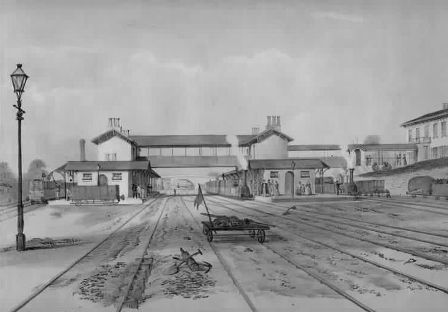
Normanton railway station 1845
An isolated location in West Yorkshire where the lines of the North Midland,
Manchester & Leeds and York & North Midland Railways conjoined.
One of the most important transmission or relay stations of
the Electric Telegraph Company, linking the north and the south.
A drawing by Arthur Fitzwilliam Tait, lithographed by Day Co., London
Normanton
Frederick Ebenezer Baines graphically described the workings of one of the most vital but isolated telegraph stations in the Electric Telegraph Company’s system in the early 1850s:
“There were two spots within the telegraphic area which were not the most ardently desired of telegraphists - Normanton in Yorkshire, and Carstairs on the Caledonian line in Scotland. The former included a railway-station and hotel; the latter, in early years at all events, little more than a signal-box.”
“All the clerks were extremely young and very frugally paid. Their ages ranged from sixteen to eighteen; they had a guinea [21 shillings] a week apiece. A few gray-beards who had attained a score of years had perhaps some shillings more, while a Methuselah of five-and-twenty, who was the clerk-in-charge, might even enjoy a weekly stipend of a couple of guineas. The latter post and pay were, however, the prizes of the profession, and not to be reached at a single bound.”
“The work was wonderfully well done considering. These youngsters, especially at Normanton, had nothing else to think of. The office at that station was a grimy room on a bridge built over the yard. Normanton owed its importance to the junction of four trunk lines of three great railway companies. Some of its public glory may have departed since the days when passengers habitually broke their journey there and slept at the station hotel. But in another way Normanton is a vaster place than ever, with a traffic which no figures can measure. Yet the social gaiety of this railway stronghold is even now not very far from what it was in the remote days of KU.”
“Here we [re-]transmitted for the North, for YO, KM, EL, and FO, i.e., for York, Newcastle, Edinburgh and Glasgow, the last being the Ultima Thule. Sometimes in fine, dry weather IK could work to KM; and a dim recollection is preserved of seeing, on one hot August Saturday afternoon, on the dial-plate at Lothbury faint defections from FO.”
“But Normanton was our frontier point. Beyond we might penetrate by chance. It did not, however, pay to work slowly, with weakened signals, into a dim and misty distance, and to stations only known to us by tradition.”
“So Normanton ‘took’ for Hull and Leeds; for York, Newcastle, Edinburgh and Glasgow, and for the town and county of Berwick-upon-Tweed. In those days, as no other towns of importance were known to telegraph clerks, could it be that they did not exist? Where were Greenock, Inverness and Aberdeen, Dundee and the towns in Fife? Where were the Hartlepools, Darlington and Middlesbrough? Bristol we had heard of, because every Saturday at noon a stock-broking message was sent around by Birmingham to go by train from Gloucester to the great town in the West. But Cardiff and South Wales - we knew them not!”
“At Normanton, amongst a galaxy of fine double-needle readers, shone a bright and particular star, FC. He was dark, young, small and slender; self-contained, gentle in his ways, and a most consummate reader. He could read off the double-needle, it was thought, with his eyes shut - even perhaps during a needful nap! Fifty words a minute, as fast as the fastest sender could work, he, with good signals, was supposed to be able to read with ease. But his glory was to read when signals were bad.”
“Imagine two clock faces, each with a single hand, standing side by side, the needle when at rest pointing to 12 o’clock. When in action, the needles shall singly, or both together, beat against ivory pins sent a little way to the right and left respectively - say at 2 minutes past 12 to the right-hand, and 2 minutes to 12 on the left. That was the normal state of things; and them distracting wobbles, numbering at top speed 400 to 500 a minute, i.e., at an average of five letters a word, and two deflections to a letter, sometimes of both needles in parallel deflections, sometimes of one needle reversing between its pins, had to be instantaneously deciphered.”
“To read the vibrations of one needle, even when the deflections were well defined, seems at first sight sufficiently difficult; but how it was that the signs of two needles moving together, or rapidly changing from one to the other, did not bewilder the reading clerk in a mystery. It is still possible for me [in 1893] to read at the rate of twenty words - that is 200 deflections - a minute.”
“When the signals were bad, distractions arose in three ways: 1) One needle would deflect strongly, the other scarcely at all; 2) one or both needles would be in contact; i.e., the messages of other wires would to some extent leak into our wires and impart irrational pulsations, which had nothing to do with, and only confused, the work in hand; and 3) nine-tenths of the current from London would run down the wet posts into the earth, or dissipate into the moist air of the Midland counties, and only a fraction would find its way to Yorkshire and feebly actuate the needles there.”
“Then was FC seen at his best. As photography discovers stars which no telescope can reveal to the human retina, so FC could read where no signal could be seen by ordinary telegraphists. Those are the days of the far away past. The double-needle has long since gone to the tomb of the Capulets, although contacts and full earth, the aurora borealis and earth-currents, still play their merry pranks in the regions of telegraphy.”
Women
As was often mentioned at the time, the telegraph companies were substantial employers of women. From its commencement the Electric company employed women as clerk-operators; competition for these positions was often embarrassingly high. Although paid less than male clerks their working conditions were far more attractive than factory, domestic or other common female employment. The Electric had separate female management, welfare, social and "toilette" facilities for the hundred women that worked in their own instrument galleries at Founders' Court and Telegraph Street, and all contact by male employees was forbidden on penalty of his immediate dismissal. Initially, and for many years - until the 1860s, women were only taken on in London, Liverpool and Manchester, none were employed in its branch stations.
In the Electric's gallery, when not actively employed at the instruments the ladies were allowed to engage in knitting, needlework and books. It was noted that they were primarily the daughters of tradesmen, with some from the families of government clerks and clergymen. There were strict age limits on their employment; they were only taken on between 16 to 23 years. It was assumed that women clerks would "retire" from their position upon marriage.
The Electric company provided their female, but not their male,
clerks with tea, coffee, bread and butter, every morning and evening.
It also allowed them fuel, light, attendance, culinary utensils, linen
and crockery for their kitchen and dining room at Telegraph Street.
"They themselves provided their dinner".
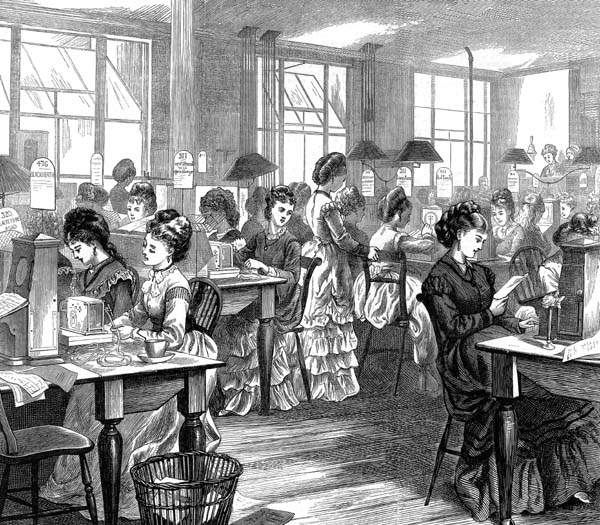
The Ladies of the Instrument Gallery
at the Electric Telegraph Company general offices
in Telegraph Street, London
The employment of women as clerks by the Electric company was
publicly advocated by its original director and largest shareholder, G
P Bidder, initially as a cost-saving measure. The success of this
innovation in both cost-saving and in public goodwill was reflected in
the general employment of women, or rather 'ladies', as clerks both at
their counters and in their back-office galleries by all subsequent
domestic telegraph companies. The London District company, in
particular, depended entirely on a female work force.
Employment in the Telegraph Industry 1861
Analysis of the Census by Leone Levi 1865
Men................................Age 10 – 15..............493
.......................................Age 15 – 20..............862
.......................................Age 20+...................1,044
Male Total.......................................................2,399
Women...........................Age -15.....................2
.......................................Age 15 – 20..............61
.......................................Age 20 – 25..............100
.......................................Age 25 – 30..............33
.......................................Age 30+...................17
Female Total....................................................213
Census Total 1861............................................2,612
Census Total 1851............................................261
As this data is drawn from census forms
filled-in by door-to-door enumerators
in 1861 the statistics are shown for
the purpose of showing approximate divisions of sex and age. In fact
the Electric and the Magnetic companies alone employed 2,638 people in
1859, without counting those working the railway telegraphs.
In December, 1858, a great political meeting was held one evening in Manchester. The 'Times' paper, in giving a report of that meeting afterwards, said: "It is only an act of justice to the Electric and International Telegraph Company, to mention the celerity and accuracy with which our report of the proceedings at Manchester on Friday night was transmitted to the 'Times' office. The first portion of the report was received at the telegraph office at Manchester at 10.55 on Friday night, and the last at 1.25 on Saturday morning. It may be added that the whole report, occupying nearly six columns, was in type at a quarter to three o'clock on Saturday morning, every word having been transmitted through the wire a distance of nearly 200 miles. Some of our readers may be surprised to hear that this report was transmitted entirely by young girls. An average speed of twenty-nine words per minute was obtained, principally on the printing instruments. The highest speed on the needles was thirty-nine words per minute. Four printing instruments and one needle were engaged, with one receiving clerk each, and two writers taking alternate sheets. Although young girls in general do not understand much of politics, there was hardly an error in the whole report."
In 1854 the Electric company had employed Mrs Maria Craig as "Matron" in charge of the lady clerks at Founders' Court. Mrs Craig made herself available every Saturday between 2pm and 4pm at the Central Station to interview the very many young ladies seeking employment. When taken on they were trained in the basics of telegraphy in classes of six on a pair of needle instruments by her in her room.
In that year, 1859, in London there were ninety women employed at the Electric's station at Founders' Court, eight at Charing Cross in the West End, two at Fleet Street and two at Knightsbridge.
Demand for the work was such that, in 1860, Maria Rye established the Telegraph School for Women at 6 Great Coram Street, London; one of several organisations she established to further female employment. Rye had previously published 'The Rise and Progress of the Telegraphs' in 1859. The secretary of the Telegraph School was Isa Craig, the Scottish poetess. Rye in her writing thanked the Electric Telegraph Company for "the liberal manner and practical form in which they have viewed the important question of female labour".
Women clerks were repeatedly recorded as being much preferred by the public in comparison to the "insolent boys" that had been previously employed behind the counters. So much so that during the 1860s the companies' belle télégraphistes even had a popular music-hall song written about their magnetic charms.
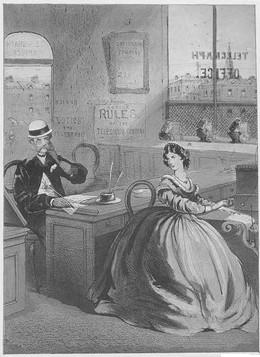
The Telegraph Song
George 'Champagne Charlie' Leybourne
'With a tap, tap, tap and a click, click, click'
'All day they sing and laugh'
'With a click, click, click and a tap, tap, tap'
'As they work at the telegraph'
The Submarine company, which handled continental traffic, did not employ women; similarly the Electric's Foreign Gallery was worked entirely by male clerks.
Many telegraph offices in Britain continued to be located in regional stock and produce exchanges in the larger cities, as the bulk of 'public' messages were actually related to business and news; others were often, but more accessible to the real public, within city hotels. In London the District company's stations were simply rented counter space in all manner of shops, where the sole telegraphic employee was almost always a woman working long hours.
A glimpse of the internal working of messages and the employment of women comes from a brief civil court case before the Oxford Assizes. A farmer dealing in strawberries at Covent Garden market on the early morning of July 17, 1861 found the weather poor and no one buying, he wished to inform his wife in Bath not to send more boxes of fruit by the railway to London as they would not sell. He called at the Electric Telegraph Company's office at Charing Cross at about 8 o'clock and was advised that a message to Bath would be received in about fifteen minutes. The farmer wrote out and sent his message. Unfortunately it took an hour and by then his wife had already sent more boxes of strawberries to London. He claimed breach of contract and £3 compensation for unsold spoilt fruit.
The Company took this suit seriously as it challenged their long-established indemnity against omissions and errors. In its evidence it demonstrated the progress of the message through its system: it was sent from the Strand to Founders' Court at 8.25 and received at 8.31. There the problems started. The message was only sent from Lothbury at 9.15, that is after a forty-five minute delay, and received in Bath at 9.18. It was delivered by messenger over a quarter of a mile at 9.25. The Company explained the delay as follows; at Founder's Court at 8.30 there were three other private messages queued in front of the strawberry one, these took ten minutes in transmission, there were also a series of mysterious service messages on the circuit to Bath. Then at 9 o'clock the day shift took over from the night shift; all of the men working at night had to leave the Telegraph Gallery before the women, who only worked during the day, could enter the room and go to their instruments – this exchange took about four minutes.The Company won. The Court found it had no contract for service with the sender and had done all it sensibly could to progress the message. One of the influences seems to have been the introduction of several of the Company's "young lady" clerks from London as witnesses; something the rustic bench of judges in Oxford were unused to. They were singled out for congratulations on the "great distinctness and propriety" of their evidence. The presiding judge observed that he did not know whether the "young ladies" were good clerks or not but they certainly made the best witnesses.
On May 28, 1866 Herbert Harlee Playford, ship and insurance broker, ice merchant and firewood importer, of 73 Great Tower Street, London, owner of a cargo of 100 tons of ice on the schooner Victor just docked at Grimsby telegraphed Rice & Hellyer, ice merchants of Hull that they could make an offer for the chilly freight. Rice & Hellyer immediately telegraphed back that they would take it at £23 a ton. On this Playford directed the Victor to sail to Hull to unload. Unfortunately Edith Smeaton, the clerk in the United Kingdom Electric Telegraph Company's head office in Gresham House, London, had miss-read the tape of the American telegraph, mistaking the £23 for £27 – the price Playford had actually accepted. Rice & Hellyer refused to accept the ice at that price and Playford sued the telegraph company for the difference, and the 1s 6d cost of the telegram. The court rejected the claim as the telegraph company had no interest in the contract for ice, and had made their agreement for service clear on their message form. Had he asked for the message to be repeated he could have claimed £5 maximum compensation. Neither had he insured the message, which with the United Kingdom company would cost £1 per cent of the risk. Miss Smeaton had two years of service with the Company and had a record of errors far less than the majority of their clerks. (The Court was informed that the figure 3 was ...--, and the figure 7 was --...)
In 1868 the telegraph companies collectively
employed 479 women. In London there were 362 - 192 at the Electric company’s
General Office in Telegraph Street, 45 at the District’s office in Cannon
Street, 30 at the United Kingdom company’s office at Gresham House, and 95 in
the other stations about the metropolis. In Liverpool there were 29 women
clerks, 14 in the rest of England, 59 in Ireland and 14 in Scotland. In comparison
there were 1,471 boy messengers employed throughout the entire system.
News-rooms
In its formative years the
Electric company opened news-rooms in the major towns it served. These
were comfortable private saloons furnished with sofas and easy-chairs
open to individual subscribers where local newspapers might be read,
cigars smoked and coffee taken. During the day news messages, commodity
and share prices were received by telegraph, announced by a clerk and
circulated confidentially within the room, usually from a wall-mounted
board.
These rooms raised the public profile of telegraphy by demonstrating the immediacy of its news delivery; and absorbed much of the early spare capacity in the Company's circuits. As public use of the telegraph grew others, especially hotel-owners and commercial exchanges, opened both public and private news-rooms for their customers and the Company gradually closed its own subscription rooms at Founders' Court, Edinburgh, Glasgow, Hull, Leeds, Liverpool, Manchester, Newcastle and Stockport during the 1850s.
News-rooms received the same service as the provincial press so were regarded as competitive by journalists; their subscribers reading the telegraph news-slips well before they could be published.
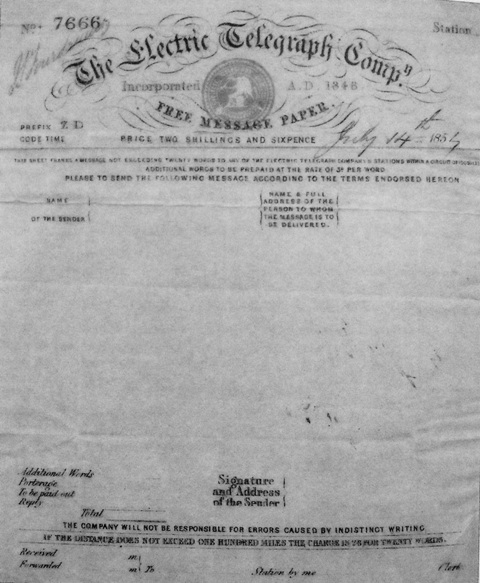
Electric Telegraph Company Stamped Message Paper 1852
Here titled "Free Message Paper", the original 1851 form had the
more accurate title "Franked Message Paper"
Pre-Paid Message Forms
From the earliest days of telegraphy books of blank message
forms with the contract terms printed on their reverse side were made
available free-of-charge for business users, and for the general
message-sending public in news-rooms and hotels. For the Great
Exhibition of 1851 the Electric company introduced pre-paid message
forms in three denominations based on distance; under 50 miles, under
100 miles and over 100 miles. They were bound in perforated books and
made available for sale at stationers, booksellers, hotels and other
outlets in London. These forms might be retailed individually for
private use to hand over at the telegraph office after inscribing one's
twenty-word message or re-sold in their bound-books at a discount to
businesses with a large telegraphic correspondence.
From December 14, 1852 these Stamped Message Papers were made available at 2s 6d and 5s 0d each, franking messages at all of the Company's stations in England, Scotland and Wales. A discount of 5 per cent was allowed on purchases amounting to £10.
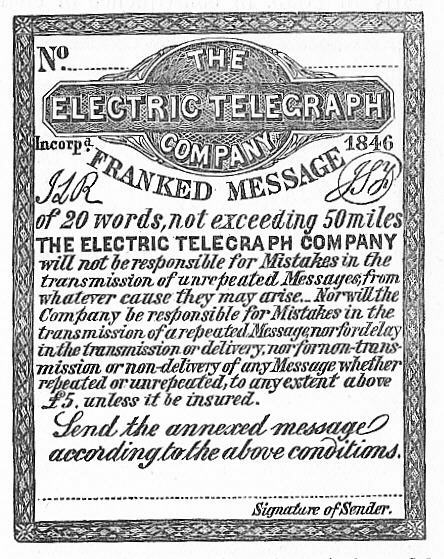
The first Telegraph Stamp 1854
The Electric Telegraph Company's very large adhesive
Franked Message Stamp
Telegraph Stamps
The Electric Telegraph Company introduced large adhesive labels, called Franked Message stamps, to
replace the pre-paid forms on June 1, 1854 at the suggestion of
its engineer, Latimer Clark, for use nationally. They were large enough
to have a summary of the Company's rules on their face and had to be
signed by the sender, but could be stuck onto plain paper as well as
pre-paying the official forms for a message of twenty words. The big
Franked Message stamps were sold in £10 blocks with a 20% discount
given in stamps, so that the purchaser received either 250 1s 0d covers
for distances under 50 miles, 100 2s 6d covers for distances over 50
miles or 50 5s 0d covers for distances above 100 miles.
The Message
Papers and Franked Message Stamps enabled many businesses to become
Agents for the Electric Telegraph Company, extending public knowledge
and acceptance of the new medium. Stationers, booksellers and
newsvendors in towns such as Birmingham, Carlisle, Exeter,
Huddersfield, Plymouth, Preston, Rotherham, Salisbury, Stamford, Wells,
Winchester and Worcester advertised themselves as telegraphic agents
between April 1854 and April 1856.
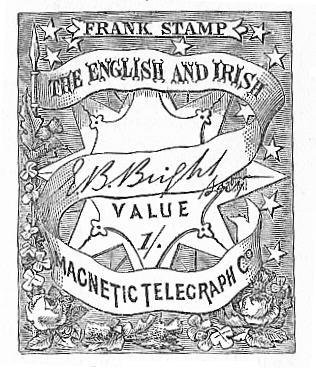
The English & Irish Magnetic Telegraph Company's Frank Stamp
The first postage stamp-sized telegraph frank.
Probably introduced late in 1854
Small Frank Stamps similar in size and appearance to postage stamps were reportedly introduced by the English & Irish Magnetic Telegraph Company sometime late in 1853; this may have been later as they were not mentioned in management reports published during 1854. Similar sized Telegraph Stamps were adopted by the Electric Telegraph Company in 1861. Most other inland companies were to issue several values of telegraph stamps to pre-pay their ordinary public message forms to cover virtually any message length and distance; these could not be used on plain paper as all messages had to have the company's conditions signed-off by the sender indemnifying it from errors.
The value of telegraph stamps was so high that they all had individual control numbers printed on their face as with bank-notes. These numbers were entered into the books of the issuing telegraph station to monitor their use, as was then customary with bank-notes. The impecunious United Kingdom company also paid bond interest with its message stamps. As examples, the:
• Electric Telegraph Company had Telegraph Stamps denominated at 3d, 6d, 1s 0d, 1s 6d, 2s 0d, 2s 6d, 3s 0d, 4s 0d, 5s 0d and 10s 0d.
• British Telegraph Company had Frank Stamps, with 1s 6d, 2s 0d and 4s 0d values.
• English & Irish Magnetic Telegraph Company had Frank Stamps, of 1s 0d, 1s 6d, 2s 6d and 4s 0d.
• British & Irish Magnetic Telegraph Company, also had Frank Stamps, valued at 3d, 6d, 1s 6d, 2s 0d, 2s 6d, 3s 0d, and 5s 0d.
• London District Telegraph Company had Message Stamps, valued at 3d, 4d and 6d.
• Submarine Telegraph Company sold Uninsured Message stamps at 4½d, 3s 9d, 4s 0d, 7s 6d and 8s 0d.
• United Kingdom Telegraph Company, had its Uninsured Message stamps,
valued at 3d, 6d, 1s 0d, 1s 6d and 2s 0d.
Stamps were issued by Bonelli's, the British & Irish Magnetic, the British, the Electric, the English & Irish Magnetic, the London, Chatham & Dover Railway, the London District, the South Eastern Railway, the Submarine, the West Highland and the United Kingdom lines. Railway-worked telegraphs did not, with two exceptions, adopt the convenience of stamps.
The message stamps of the Electric Telegraph Company always bore its
original title, without the awkward "& International"
addition.
Uniquely, from c 1860 the Electric’s
directors were provided with Director’s Message stamps that could frank telegraph
messages of any length without pre-payment; unsurprisingly several thousand of
such were issued to and used by its board members.
Telegraph stamps were more popular with the general public and more
flexible than the Electric's pre-paid forms in that both distance and
message length could be allowed for by combining denominations. It
should be emphasised that only a small percentage of telegraph messages
were pre-payed by frank stamps; the majority were paid for in cash at
the counter.
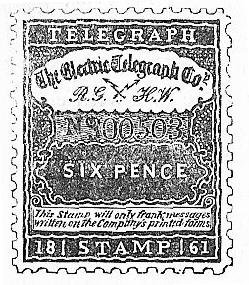
The Electric Telegraph Company's Telegraph Stamp 1861
A postage stamp-sized replacement for the large Frank Message Stamp
The earliest forms and the adhesive stamps of all companies were
"signed" or initialled in lithography by the company secretary. In the
case of the Electric Telegraph Company this was J S
Fourdrinier or Henry Weaver, and, for that company, also by the
chairman, J L Ricardo or R Grimston.
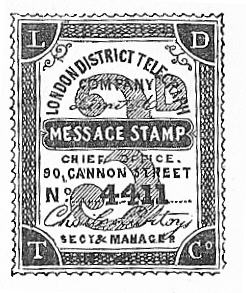
The London District Telegraph Company sold its 6d message stamps bound into small books with ten pages of six stamps in 1861. This was the first use of booklets for retailing any form of stamp, telegraph or postal. The District was to introduce many other promotional ideas into its business; it offered the public one hundred 6d stamps for one pound (240d) for a period in 1862, a rate of just 2½ d for fifteen words.
The Company introduced Contract Messages for tradesmen by which anyone purchasing one pounds worth of free message stamps could commence an open account for future messages without pre-payment. It had previously offered tradesmen a similar deal in which customers could place orders by telegraph free-of-charge, the tradesman paying in advance for one hundred messages for £1. A bonus of 500 free printed leaflets with details of the tradesman's business was also included in the offer. For example, in 1862 the Imperial Wine Company of Oxford Street, among many other similar concerns, advertised that orders for its fine wines and spirits could be given free at any office of the District company.
On January 2, 1862 the District company offered, for the first time Trade Circulars by Telegraph at its trade rate of 100 messages for 20s. This discount encouraged Maurice and Arnold Gabriel, trading as "Gabriel, the Old Established Dentists", to send out advertising telegrams from their practice, which had been founded in 1815 at 27 Harley Street, London, to a mass of people including government ministers on May 29, 1864. The simple message read: "Messrs Gabriel, dentists, Harley-street, Cavendish-square. Until October Messrs Gabriel's professional attendance at 27, Harley-Street, will be 10 till 5". It led to public uproar at what was seen as a vulgar misuse of the new medium. The District was the only company that permitted messages, other than those for the press, to be sent on account, that is without pre-payment.
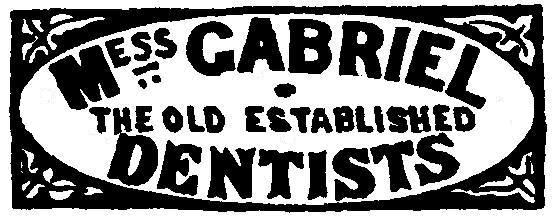
The first electric advertiser 1864
Little did they know that it would lead to billions of similar
messages
The General Private Telegraph Company in Manchester imitated the District company in May 1864. It, too, offered tradesmen "franked or free message forms" for use on its single circuit at the suburban railway stations between Manchester and Altrincham so that their customers might place orders. The facility was used by Richardson, Roebuck & Company, "Grocers & Purveyors to the Queen" in Manchester.
Free Passes
Sometime in the 1860s the Electric
Telegraph Company introduced Annual Free Passes on ivory plaques that allowed
individuals to send messages on their private business without pre-payment.
These supplemented its Director’s Message frank stamps, and were provided to
senior managers and strategic individuals.
Electric Banking
The Electric company
introduced money remittances by telegraph in January 1854, in return
for a small per cent of the amount. This speedily transferred sums
between its largest offices, where it maintained a substantial
cash-float - from London to Liverpool, Manchester and
Newcastle-upon-Tyne; and from Birmingham, Bristol, Dublin, Edinburgh,
Exeter, Glasgow, Hull, Leeds, Liverpool, Manchester,
Newcastle-upon-Tyne, Plymouth, Portsmouth, Sunderland and York to
London. In many countries the telegraphic money order is the last relic
of telegraph business.
By the 1860s the Electric Telegraph Company was offering more sophisticated services to the mercantile community. A trader could retire bills-of-exchange due in London telegraphically by paying-in the sum due along with a small commission; for example, paying off a £50 bill at Manchester on an account in London cost 4s 0d as well as 1s 0d for the message. The Company employed the new joint-stock Imperial Bank, created in May 1862, at 6 Lothbury, a few yards away from Founders' Court, rather than its corporate bank, Glyn & Co., to complete these transactions. A number of the Company's managers, engineers and clerks were shareholders in the Imperial Bank.
Wayleaves
Railway companies exchanged the
right of the telegraph company to carry their public wires alongside
their lines for private wires for their own use in signalling and
internal message traffic. This was particularly so with the Electric
company who by this means avoided wayleave (rental) payment for these
rights. In Ireland the Magnetic company was similarly dominant over the
railways, but, except in the North country where it was founded, it had
to use road-side underground wires and poles on most of the English
mainland. Whilst the companies acquired Parliamentary approval to lay
wires alongside public roads, the municipal and turnpike authorities
were still able to bargain for wayleaves. In England the new United
Kingdom company was initially compelled to use canal-side overhead
wires for the backbone of its system, in 1861 which the original
Electric Telegraph Company had to do in Ireland a few years later.
Due to the manner in which rights-of-way were acquired by the several companies around one-half of telegraph offices were located at the local railway station. This was not necessarily the most convenient place for the public as the newly-constructed railways were made on the outskirts of many towns rather than through their expensive built-up areas; and, as has been mentioned, railway stations at the time were often closed between train arrivals. The telegraph company, in major cities, would frequently open a town office with a road-side overhead or underground branch wire from the railway station.
In London, by 1855, the Electric possessed nineteen telegraph offices – ten at railway stations, five in the residential West End and four in the business centre in the City. There were also other offices open 'part-time' at periodic cattle markets and in the Houses of Parliament for when the two houses were sitting. In the following year it had opened twenty-four telegraph offices in London. As noted, to gather messages in bulk the Company introduced small-bore pneumatic tubes from busy branch locations to its central office in 1853.
The other large cities in Britain, Birmingham, Liverpool, Manchester, Newcastle, Glasgow and Edinburgh, and Dublin, had just two or three offices; these were in either in the business districts or at the railway stations.
Along several railways the telegraph
company and the railway company shared use of the wires rather than having
separate circuits. This, it was claimed, could delay the transmission of public
messages in favour of those for the railway.
In 1868 the principal “shared
lines” were noted as London to Tunbridge, Tunbridge to Ashford, London to
Tonbridge Wells and Hastings, (all on the independent circuits of the South
Eastern Railway), Brighton to Portsmouth (London, Brighton & South Coast
Railway), London to Bristol (except for Bath, Chippenham, Swindon and Reading,
where other circuits connected) (Great Western Railway), Exeter to Bideford and
Barnstaple, (London & South-Western Railway), Norwich to Ipswich and East
Anglia and North Norfolk generally (Great Eastern, lately Eastern Counties, Railway),
Birmingham to Leeds (except for Burton on Trent, Derby and Chesterfield, again
where other circuits connected) (Midland Railway), Carlisle to Glasgow (Caledonian
Railway), in Ireland, Dublin to Galway (Midland Great Western Railway), Dublin
to Wicklow and Enniscorthy (Dublin, Wicklow & Wexford Railway), Waterford to
Limerick (Waterford & Limerick Railway) and Dublin to Enniskillen (Dublin
& Drogheda Railway).
Several substantial railway companies, the South Eastern, the London, Brighton & South Coast, the London, Chatham & Dover, the Lancashire & Yorkshire, the North British and the Caledonian being the principals, chose to work their own public telegraphs in circuit with one or other of the telegraph companies, using that company's electrical system but with their own clerks and offices, so keeping the local revenues. Some were to take this option on renewing their previous contractual relationship with the telegraph company. Where this was the case the extension of wire beyond the railway's property into town centres was neglected and led to considerable public annoyance. In a few instances the public were served by neither railway nor telegraph, or, more often, the railway station was at some inconvenient distance from the town centre.
By 1868 railway companies directly managed 22% of the public
telegraph lines but only carried 6% of the traffic. This inefficiency
was a factor that led to the call for state intervention.
Foreign Parts, before the Cable
From the earliest days when the first
electric wires connected the mercantile cities with Britain’s ports, well
before underwater cables were laid, telegraph messages could be despatched for
forwarding by overseas post to all parts of the world. The telegraph office in
the port would simply add the necessary frank stamps to the message envelope
and put it in the foreign mail, saving twenty four hours or more in time.
This was a service intended almost
entirely for the commercial and mercantile community, where message cost was balanced
against potential risk. It was advertised only in the commercial press of the
time.
The simple forwarding procedure developed
considerably during the 1850s, with the telegraph companies co-operating with steamship
lines to offer an accelerated message service to the most distant parts, exclusive
of the Post Office. The Magnetic company, for example, accepted messages for America
at its Liverpool office as early as 1852, using an independent forwarding agent.
In addition the messages could now be sent on from the receiving port overseas by the local
telegraph provider to any inland destination, all at a set tariff.
As the European telegraph network
extended by the mid-1850s telegraph messages were being sent to distant ports
such as Marseilles and Trieste to be put aboard the scheduled mail steamers for
Egypt on the route to India, China and Australasia, saving many days over the
ordinary post.
The American route was similarly shortened
by having telegraph messages put aboard and collected from the Atlantic liners
at the Irish out-ports of Galway, Queenstown and Londonderry. This developed to
such an extent in the early 1860s that dedicated wires were laid to these remote
coastal stations and message transfers made to the liners using waterproof containers
and nets as they steamed past, without stopping. The principal traffic was news
or of a commercial nature, related to the American war.
The international forwarding or transfer tariff
was based on the usual twenty- word message length and on standardised zones or
groups of destinations. For America messages could be sent from London an hour
before the mail steamer was due to sail, or an hour-and-a-half from the provinces.
Most of these transfer systems were abandoned
with the completion in the late 1860s of land lines and cables connecting Britain
with the Levant, America and the Far East.
Management
It wasn't until the 1860s that a specific class of management
appeared independent of other business disciplines: Sir James
Carmichael and John Pender of the Magnetic, Robert Grimston of the
Electric, and Richard Glass of Glass, Elliot, were among the very few
who came to prominence as strategic directors rather than technicians.
This group of strong personalities eventually was to dominate the world-wide cable network created between 1865 and 1900. None were to be associated with the Post Office telegraph monopoly.
Others left the stage early; William Ponsonby, Lord de Mauley, chairman of the Submarine Telegraph Company, and a considerable force in its ultimate success died in 1855, aged 68. John Watkins Brett, the pioneer of world-wide submarine telegraphy, was sadly to die in 1863, aged just 59.
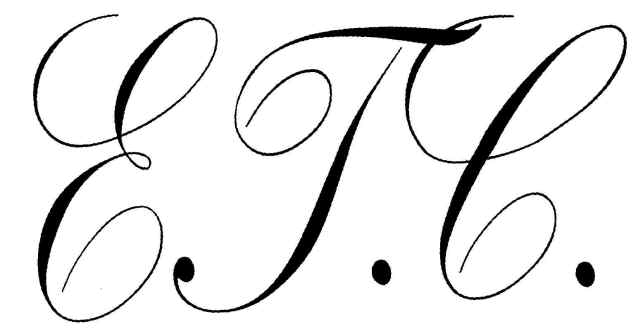
The monogram of The Electric Telegraph Company
Engraved and cast on to equipment, hardware, buttons and badges,
and embroidered onto uniforms from 1846 until 1868
Although "officially" the 'Electric & International Telegraph Company'
from 1855, it was permitted in law to retain the old title and used
this monogram until the end
Labour
Experienced male clerk-operators in
the three principal telegraph companies earned between 14s and 25s a
week in 1860. This was well-above the average wage of the period. Women
clerks, 19% of the total in 1868, were paid between 10s and 14s per
week for essentially the same work.
For example, a nineteen-year-old male "learner" with the Electric company in 1852 was taken on unpaid probation. After a month, once he reached a proficiency of sending twenty words and receiving fifteen words a minute, he was appointed junior telegraph clerk at 14s 0d per week and received his Book of Instruction, giving all of the Company's rules and regulations. This pay continued for two years, with an additional 3s 0d a week when posted away from home and with 4d an hour paid for work overtime. At age twenty-two years he was appointed telegraph clerk and was paid 20s 0d a week, this increased later to 22s 0d, his overtime rate increased correspondingly. At twenty-four he began working on the foreign circuits in London at 26s 0d a week, increasing to 30s 0d. At age twenty-five in 1858 he was appointed chief telegraph clerk at a provincial station at 40s 0d a week.
Male clerks could be taken on at fourteen years of age, so were
quite literally 'boys'. Women were employed from age sixteen years.
There were deductions from salary for negligence; one-eighth of a day's
pay for illegible or careless writing; for playing, absence without
leave, errors in figures and dates, and disorderly conduct; and for
insubordination. For miss-spelling and special errors, one-quarter of a
day's pay; for gross message errors and loss of message a whole day's
pay. They were liable to be transferred between offices at the will of
the Directors, but the Company paid the expenses incurred.
One of the more exciting or flagrant misuses of the Electric's circuits occurred on March 17, 1867 when a boy clerk at Southampton responded to an enquiry about Irish news from a similarly young colleague at Newport on the Isle of Wight with the following: "Private. Dublin. Fortifications attacked. Two thousand Fenians killed and wounded. Telegraph office burned down. Fleet of Fenians off Liverpool expected to attack that port today." This foolish joke somehow fell into the hands of the Vicar of Newport who read it to his Sunday congregation in good faith. It is not known what happened to the culprits, although the vicar pleaded with the Company for leniency.
In balance to this there were premiums paid for special services, such as working important messages, government proclamations and some foreign news, for example. The fast and accurate transmission of the Queen's Speech on the opening of Parliament each year was one of these, the speed of this often being mentioned in the press. Fourteen days holiday were allowed each year from 1854, and clerks were additionally rewarded for holiday relief and other overtime working. Should a customer require a clerk to work longer than their duty hours they had to pay for the time and the clerk kept the entire amount as a gratuity, this had to be recorded in the books.
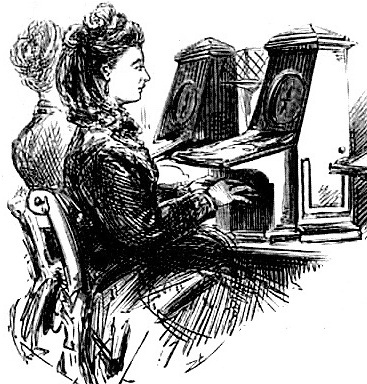
Ladies working the Highton single-needle telegraph 1870
Female clerks were always known as "ladies" in the companies' service
James Graves, who joined the Company in 1852, recorded his progress through training at Founders' Court in London:
"In the establishment there is a room set apart entirely for 'learners' in which are connected up in the usual manner instruments in pairs, one representing the sending station's instruments and the other that of the receiving station. Thus 'learners' are enabled to hold conversation with each other in the same room the same as in the instrument rooms the clerks hold communications with stations hundreds of miles distant."
"This 'Learners Gallery' (as it was termed) contained two pairs of needle instruments and one pair of printing instruments at the time that I entered as a "Learner" which was on the 27th day of December 1852. Well knowing that I should receive no wages till I was competent to work the instruments tolerably well and being very short of funds, I resolved to work as hard as I could at them in order that I might in the shortest possible time be prepared to pass my examination. I strove hard and in a few days I became so far initiated in it that by double needle I could read on an average about five or six words per minute. At the end of the first week I could read ten words per minute. From ten to twelve being the required complement to pass my examination I left that and commenced the second week with single needle. In this I progressed very rapidly and occasionally practised the double needle. At the end of the second week I was prepared to pass the examination which I have since known some learners to be studying for three or even six months, viz. to read twelve words double and six words single per minute. I sent in my request to be examined. As there were no more ready the Examiner would not examine one that week but said I must wait till the following week, when some more could be ready, and in the meantime I was to learn the printing telegraph. This I set about with the same spirit and by dint of perseverance I was able to read and send tolerably by printing at the end of the third week, when having successfully passed my examination in the double and single needle I was removed from the Learner's Gallery into the East Gallery or Instrument Room. On entering this Department I was appointed 'writer' to the Manchester printing instruments. The complication of codes of different kinds puzzled me at first but in two or three days they began to be familiar and I got on very well."
At Founders' Court the clerks worked three overlapping nine hour shifts, from 8am to 5pm, 9am to 6pm and from 11am to 8pm. Only older men, no boys or women, were allowed to work the later shift.
In the Foreign Gallery the instrument clerks all spoke a foreign language, mainly German. In fact English was rarely spoken at all as the first language in this department during the 1850s and 1860s.Telegraph company clerks working at railway stations shared the privilege of railway employees of having free third-class travel over their particular system.
C F Varley gave details of transmitting and receiving performance of the Electric company’s clerks in the summer of 1862. Using the American telegraph it was possible to send 35 words per minute over 200 miles of No 8 gauge iron wire, however the working average was 22 words, and an hour’s work usually being undertaken, with breaks and pauses, at 12 to 15 words per minute. The “average word” was found by experience to be 4½ to 5 letters in length, but the public by then were omitting “a”, “of”, “the” and “in” from their messages to save on cost. Varley mentioned that the German Austrian Telegraph Union, with which the Company co-operated, insisted that “dampfschifffahrtgesellschaft” (steamboat company), among many other such, be treated as a single word in its tariff.Apart from operator skill other factors affecting speed were the contact points of the local relays used with the American telegraph becoming burnt and rough, and quarrelling among clerks when too many repetitions of words were needed.
As it required an unusually large number of clerks in London, the Electric Telegraph Company's Boarding House at 3 Albion Place, Blackfriars Bridge, was opened in 1854 to lodge single men in its employ and kept in use during the 1860s. It was a short walk over the bridge on the river Thames to Founders' Court.
It formed, too, as a benefit for its clerks on distant stations a Travelling Library to provide the latest popular and educational books, which would otherwise be beyond their expense. It was, unfortunately, partly funded by the small fines levied on clerks for errors.
Although the sexes were rigorously separated in the telegraph galleries at Founders' Court and Telegraph Street, to the extent of using separate entrances, in the 1860s both men and women participated in the theatricals and concerts of the Electric & International Drama Club. Its sixty members managed regular events every quarter at the Cabinet Theatre, Liverpool Street, King's Cross, London. As well as straightforward entertainment it held benefit performances in aid of incapacitated co-workers and to raise money for the Telegraph Clerks' Provident Fund.
The Other side of New Technology
The boilers and engine driving the pneumatic pumps in the basement
of the Electric Telegraph Company general offices
in Telegraph Street, London
The Electric Telegraph Company contracted with the Provident Clerks' Mutual Life Assurance Association of 15 Moorgate Street, City, in 1857 "for the purpose of affording to clerks and others the means of making a provision for themselves in old age, for their families at their decease, and an endowment for their children". The 'Provident' had created the first group life schemes for the protection of the employees, including those of the Post Office, the Great Western Railway, other railway companies, and many other large scale employers. It was a voluntary scheme to which any of the Company's clerks might contribute to receive sums in sickness, old age and on death in service. The Electric would provide from one third to one half of their premiums.
Not all companies were as beneficent as the Electric and this led to the charitable, non-profit-making Telegraph Clerks' Provident Fund, open to all employees of the telegraph companies not just clerks, being formed in October 1863 "to afford medical advice, medicines and pay in sickness, a provision for old age, and a sum of money at death". Its constitution was approved by an actuary and by the boards of directors of all the telegraph companies. The directors and charitable individuals such as Julius Reuter contributed to its Fund. Selina Oppenheim, Lady Superintendent at the London District Telegraph Company, became secretary to the Fund alongside of her main work. The District also allowed the Fund free use of its Cannon Street premises. The Princess of Wales agreed to become its first Patroness; Her Royal Highness was soon joined by one of her sisters-in-law, Princess Louise, and other noble gentlemen and women.The Fund provided benefits on incapacity through illness and was agent for government annuities, so providing pensions. Three honorary physicians were recruited and medical prescriptions were made available at cost through an apothecary. The main benefit was the provision of sickness insurance, subscribers to the Fund received 10s 0d a week in the event of illness with free medical attendance or an additional 2s 6d a week, until age 60. There was an additional death-in-service payment of £10. Age 15 to 20 years the cost was 1s 1d a month for sickness and 4d for death benefit, age 20 to 25 1s 2d and 5d, age 25 to 30 1s 3d and 6d, age 30 to 35 1s 4d and 7d, and age 35 to 40 1s 5d and 8d.
There was some criticism of the complexity of its entry criteria from the Magnetic company's employees but the Fund was widely supported with donations as well as subscription by clerks, managers and directors. Subscribing member clerks and employees came from the Electric, Magnetic, United Kingdom and London District companies. At the end of its first year the Fund had seventy-one members, sixty being from the District company in London. There were two beneficiaries during the year. As well as subscriptions and donations, theatrical entertainments were organised to raise additional money for its use, an example was a large summer soirée and conversazione with music, drama and comedy performed by the clerks at Barnsbury Hall, Islington, in north London on Monday, August 8, 1864.
With the prospect of state control looming, the members of the Telegraph Clerks' Provident Fund voted for its dissolution in March 1869.
The pay and conditions of telegraph clerks were not uniformly held in high regard. The Guildhall Court in the City of London on November 19, 1860 had the case of Henry Thomas Joyce before it. He was charged with stealing £7 15s 2d from his employers, the British & Irish Magnetic Telegraph Company in September, for whom he worked seven years, when a clerk at their station in Lloyd's Rooms, the shipping insurance market. The Aldermen on the bench were surprised that Joyce, an orphan, had first been employed as a Messenger with the Company when aged 12 at 5s 0d a week with a uniform provided, working an eight hour day; then when promoted to Junior Clerk he received 10s 0d a week but lost his uniform, having then "to keep up a respectable appearance... and maintain himself as a clerk". Joyce, an orphan, lodged with his sister, paying her his rent but keeping himself in food and clothing out of his modest wage. The Court expressed strong sympathy with his circumstances but had no choice but to sentence him to twenty-one days imprisonment; members of the public donated money for the benefit of his sister once the case was reported.
C H Curtoys, then the Magnetic company's Assistant Secretary and District Manager for London, said that, whatever the opinion of the court as to their pay, they were "besieged" with applicants for jobs as Messengers. In addition the Company had not known that Joyce did not have the support of a family.The 1860s was a decade of the social Soirée. The clerks of the telegraph companies were eager as anyone to participate in these large, genteel events, no doubt encouraged by the District Superintendents who saw their publicity value. On April 6, 1864 the Dean Clough Institute in Halifax, in the West Riding of Yorkshire held their first in the Odd Fellows' Hall, "when upwards of 500 persons sat down to an excellent tea. The spacious room had been tastefully decorated for the occasion with mosaics, banners, festoons, and fabrics of various hues, and mottoes". Clerks of all three national telegraph companies were represented.
After some singing by the ladies "the remainder of the evening was devoted to telegraphic experiments, wires having been fixed in all parts of the room; and these were quite an attractive feature, and were well received. The working of the electric telegraph was superintended by Mr L J Crossley, and between the Hall and Manchester, Hughes' roman type printing telegraph was used, which the United Kingdom Telegraph Company have the sole privilege of working on their lines. Then there was Sir Charles Bright's bell instrument, between the Hall and Leeds; and Messrs Siemens, Halske & Co's ink writing instrument between the Hall and Leeds, London, Bradford, Hull and Manchester; also, Messrs Cooke & Wheatstone's single-needle instrument between the Hall and Sheffield direct. Then there was Messrs Siemens, Halske & Co's dial instrument, and Messrs Cooke & Wheatstone's double-needle instrument from one end of the room to the other. During the evening several messages were despatched by persons in the audience to the various towns already named, and answers were in every case promptly received. One of those questions was to Leeds, and was as follow: "Which town do you think is entitled to be considered the metropolis of the West Riding?" the answer to which was, "Why, Halifax, I should say, of course" (laughter)."The organisers thoughtfully thanked the companies' local employees and "expressed the obligations the meeting was under to the telegraphic clerks in London, Manchester, Leeds and other places."
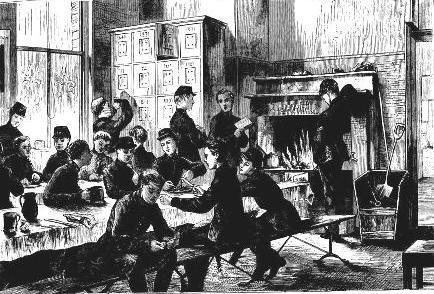
The Boy Messengers' Kitchen at the Electric Telegraph Company's
General Offices 1870
Messengers were employed from age ten years. They received 7s 0d a
week in 1862. They were not allowed gratuities in duty hours but might
keep all payments received from recipients, for cabs and so forth, for
work overtime. They were encouraged to take an interest in the
telegraph with a view to them becoming clerks.
The boy messengers were the only employees
issued with uniform clothing. Those of the Electric Telegraph Company were
issued with a coat, trousers and a cap, as well as a leather pouch. The frock
coat was in dark-blue with a scarlet collar and scarlet cuff piping, the trousers
were grey. The cap was dark-blue with a broad scarlet band and a leather peak, originally a
flat-topped military pattern, later in the French-style, a kepi. The ETC monogram
was embroidered on the cap and collars of the coat, and featured in metal on
the pouch.
The ‘competitive’ Post Office
letter-carriers wore a scarlet coat from 1794 until 1860, with a hat rather
than a cap. In 1861 the Post Office also adopted dark-blue.
It has to be said that the boy messengers
were not generally regarded favourably, being notorious for their “attitude”
and, apparently, none too clean in their appearance. One Post Office report claimed
that those at the Electric’s principal office in Telegraph Street were “a set of
irreclaimable scamps” who occupied their spare time “putting [shoe] blacking
into the tea of the other boys, or putting mice into the pneumatic tubes, or by
bathing in the water tank at the top of the central station on a hot summer’s
day”.
Every clerk was
appointed by the Board of Directors through the Secretary's office.
They had to sign a Declaration of Secrecy before entering service. The
messengers were appointed by the Chief Clerks at stations or by the
District Superintendents, but even such a junior post had to be
confirmed subsequently by the Board.
In the District company the lady clerks were paid nothing during their
training. On achieving five words a minute on the single-needle
instrument they were paid 5s 0d for a six-day week; eight words a
minute was rewarded with 8s 0d a week; up to a maximum of 10s 0d for
ten words a minute. Two weeks annual leave was allowed.
The boy messengers working for the District were originally paid 4s 0d a week. This was changed in 1861 to a piece-rate of 1d a message. They could, it was said, then earn between 2s to 3s a day.
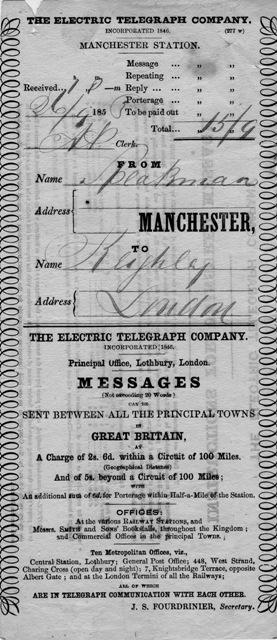
Electric Telegraph Company Message Receipt 1853
Provided to the sender as proof of despatch
The cost of this message from Manchester to London on September 26, 1853
is shown as 15s 9d, ten years later a 20 word message would be 1s 0d
The Postman Calls
The replacement of the
telegraph companies' clerks and messengers by Post Office officials
provoked a number of code books for use by the general public. The
reason is given in the introduction to Robert Slater's 'Telegraphic
Code, to ensure secrecy in the transmission of telegrams' that appeared
in 1870 – "those who have hitherto so judiciously and satisfactorily
managed the delivery of our sealed letters will in future be entrusted
also with the transmission and delivery of our open letters in the
shape of telegraphic communications, which will thus be exposed not
only to the gaze of public officials, but from the necessity of the
case must be read by them. Now in large or small communities
(particularly perhaps in the latter) there are always to be found
prying spirits, curious as to the affairs of their neighbours, which
they think they can manage so much better than the parties chiefly
interested, and proverbially inclined to gossip." As well as Slater's,
there appeared within a few years 'Watt's Telegraphic Cypher', the 'ABC
Universal Code', 'Banking Telegraphy', the 'Three Letter Code', and the
"most comprehensive and voluminous" of them all, 'Bolton's Telegraph
Code' of 1871 with a thousand pages.
Complaints by the public rose from an average one in 2,000 messages under the companies in the 1860s to one in 600 under the Post Office in 1871.
At the parliamentary inquiry on the appropriation of the telegraphs
in 1868 Professor Wheatstone strongly advocated public use of his
pocket cryptograph or cipher machine to counter any possible
'intrusion' by inquisitive postal officials. It was, after all, he
carefully pointed out, already used by the government for just such a
purpose...
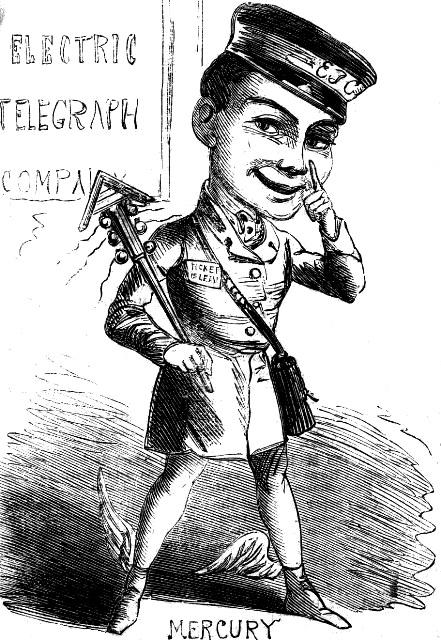
A satirical view of the Messengers, the "Mercuries", of the
Electric Telegraph Company in 1855
More often than not described in the press as "insolent boys"
Telegraph, from the Greek “tele”, distant, and “graphos”, writing